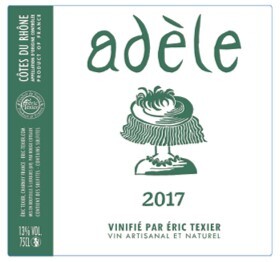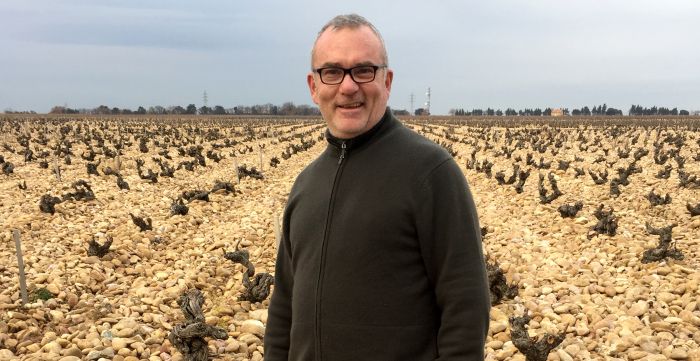
producer profile
27.06.2019
Eric Texier Producer Profile
<p>It is no exaggeration that Eric Texier is one of the most important people we have come to know in our 30+ years of wine importing. Not important in a boisterous or regal sense, but rather from an evolutionary perspective. People like Eric and his wife Laurence helped us discover that mutual respect, growth and friendship were possible in this line of work, that a "business relationship" could shape philosophies, world views, values and even our senses of humor! For this we are grateful. </p>
<p>A <glossary title="178">Bordeaux</glossary> native who has lived in or around Lyon since 1979, Eric is a jovial, energetic and fun-loving person who wants his wines to make their drinkers happy. But he is also a boundary pusher, endlessly questioning his own work (and let's be honest, the work of others) for the sake of moving <glossary title="1103">viticulture</glossary> and winemaking forward.</p>
<p>Eric is a trailblazer, having put the all but extinct regions of <glossary title="204">Brézème</glossary> and <glossary title="889">Saint Julien en Sain Alban</glossary> on the map. He experiments with concepts you rarely if ever hear about elsewhere: finding <glossary title="71">acidity</glossary> in <glossary title="634">Marsanne</glossary> through <span class="zalup"><span> <glossary title="103">anforas</glossary><span>,</span></span></span> not working the soil in favor of <span class="zalup"><span><glossary title="1255">cover crops</glossary><span>,</span></span></span> "<glossary title="1378">infusion</glossary>" style <span class="zalup"><span><glossary title="610">macerations</glossary><span>,</span></span></span> working on his own <span class="zalup"><span><glossary title="500">grafts</glossary><span>,</span></span></span> rediscovering forgotten grapes adaptable to the very real threat of climate change...</p>
<p>Strongly opinionated, he is not afraid to ruffle feathers or call people out on their <em>bullsheeeeet</em> in his heavily accented but perfect English. And since Eric always backs his claims with serious research, careful thought and true care for the subject matter, you'd best think twice before writing him off. I mean, the guy used to be a nuclear engineer!</p>
<p>Having said that, Eric loves to learn and exchange. And he can even admit when he's wrong! One of the things we are most proud of here at <glossary title="1324">LDM</glossary> is the cross-pollination of growers we work with: growers who've befriended each other, talked shop for hours and drawn inspiration from each other's know-how and techniques. Eric truly is the poster child and "the glue" of so many of these friendships. </p>
<p>He originally became a winemaker after a first career as an engineer in the nuclear industry and without any family background in vines or wines. As such, his goals and methods developed not so much from his years of schooling, but from his readings, his visiting winemakers around the world, and working in <glossary title="212">Burgundy</glossary> with Jean-Marie Guffens at Verget.</p>
<p>After giving up the idea of buying vineyards, which was too costly a proposition for a beginner with his ambitions, he started a small <glossary title="729">négoce</glossary> where he selected particularly interesting vineyard <glossary title="1133">plots</glossary> worked by the sincere, hard-working farmers who grew the healthy grapes he wanted to buy and <span class="zalup"><span><glossary title="1104">vinify</glossary><span>.</span></span></span> He rediscovered nearly forgotten areas of ancient fame, like <glossary title="204">Brézème</glossary> in the northern <span class="zalup"><span><glossary title="372">Côtes-du-Rhône</glossary><span>,</span></span></span> and nurtured relationships with people who tend their vines with passion and care. Over the years, the shift from <glossary title="729">négociant</glossary> to <glossary title="1089">vigneron</glossary> has occurred, and today Eric owns and rents the vast majority of the vines that go into his production. He has also replanted several <glossary title="523">hectares</glossary> in <glossary title="204">Brézème</glossary> and in <glossary title="889">Saint-Julien en Saint-Alban</glossary> with <glossary title="1001">Syrah</glossary> and <span class="zalup"><span><glossary title="878">Roussanne</glossary><span>.</span></span></span></p>
<p>In his purely <glossary title="729">négoce</glossary> days, Eric was producing 30 different wines from 10 different origins, mostly but not limited to the Northern <span class="zalup"><span><glossary title="1209">Rhône</glossary><span>.</span></span></span> As a land owner and <span class="zalup"><span><glossary title="1089">vigneron</glossary><span>,</span></span></span> he produces 12 different wines from four different origins, with the <span class="zalup"><span><glossary title="373">Côte Rotie</glossary><span>,</span></span></span> <glossary title="845">Rasteau</glossary> and <glossary title="277">Châteauneuf du Pape</glossary> the only remaining <glossary title="363">cuvées</glossary> made with purchased fruit. </p>
<p>The wines are <glossary title="1104">vinified</glossary> in their areas of production, which means a lot of time management and traveling at the time of <span class="zalup"><span><glossary title="521">harvest</glossary><span>.</span></span></span> When they have obtained their <span class="zalup"><span><glossary title="108">AOC</glossary><span>,</span></span></span> the young wines are transported to <span class="zalup"><span><glossary title="273">Charnay-en-Beaujolais</glossary><span>,</span></span></span> just north of Lyon, where Eric lives and owns a wonderful <glossary title="418">élevage</glossary> <span class="zalup"><span><glossary title="254">cellar</glossary><span>.</span></span></span> This beautiful underground, vaulted <glossary title="254">cellar</glossary> was built in the 16th century, and temperatures stay cool and stable through the year.<br />
<br />
Like all good winemakers, Eric strongly believes that wines are made in the vineyard, and that his work, after the <span class="zalup"><span><glossary title="521">harvest</glossary><span>,</span></span></span> consists in following the lead of the <glossary title="1109">vintage </glossary>and accompanying the wines so they fulfill their potential. Exact steps in <glossary title="1104">vinification</glossary> vary according to the <span class="zalup"><span><glossary title="1071">varietals</glossary><span>,</span></span></span> <glossary title="1026">terroirs</glossary> and <span class="zalup"><span><glossary title="1109">vintages</glossary><span>,</span></span></span> but the goal is always to provide the grapes, <glossary title="700">musts</glossary> and wines with the best environment and to intervene as little as possible.<br />
<br />
His techniques for white wines include <glossary title="1380">sorting</glossary> in the vines and at the winery, <glossary title="1124">whole clusters</glossary> pressed in a <glossary title="935">vertical press</glossary> (that’s the old fashioned <glossary title="1126">wood</glossary> kind), no added <span class="zalup"><span><glossary title="1128">yeasts</glossary><span>,</span></span></span> <span class="zalup"><span><glossary title="142">barrel</glossary><span>,</span></span></span> <glossary title="325">concrete</glossary> and ceramic <glossary title="441">fermentation</glossary> (no <glossary title="717">new wood</glossary>), <glossary title="74">aging</glossary> on <span class="zalup"><span><glossary title="448">fine lees</glossary><span>,</span></span></span> <glossary title="622">malolactic fermentation</glossary> for all the wines, minimal use of <glossary title="993">SO2</glossary> at <glossary title="185">bottling</glossary> only, no <span class="zalup"><span><glossary title="850">pump-overs</glossary><span>,</span></span></span> <glossary title="449">fining</glossary> and <glossary title="447">filtration</glossary> only when absolutely necessary.</p>
<p>For his red wines, he does the same <glossary title="1380">sorting</glossary> at <span class="zalup"><span><glossary title="521">harvest</glossary><span>,</span></span></span> no <glossary title="378">destemming</glossary> most of the time, bringing the grapes to the <glossary title="935">press</glossary> by conveyor belts, <glossary title="317">cold maceration</glossary> under a <glossary title="310">CO2</glossary> blanket for <glossary title="120">aromatic </glossary>extraction, <span class="zalup"><span><glossary title="538">natural yeasts</glossary><span>,</span></span></span> very little to no <glossary title="433">extraction</glossary><strong><glossary title=""> </glossary></strong>during <glossary title="610">maceration</glossary> and <span class="zalup"><span><glossary title="441">fermentation</glossary><span>.</span></span></span> The temperatures are controlled not to exceed 34 degrees C (93F), <glossary title="74">aging</glossary> is done mostly in <span class="zalup"><span><glossary title="325">concrete</glossary><span>,</span></span></span> old <glossary title="462">foudres</glossary> and <glossary title="388">demi-muids</glossary> of 450L, no <glossary title="447">filtration</glossary> and egg white <glossary title="449">fining</glossary> in extremely rare cases.</p>
Article
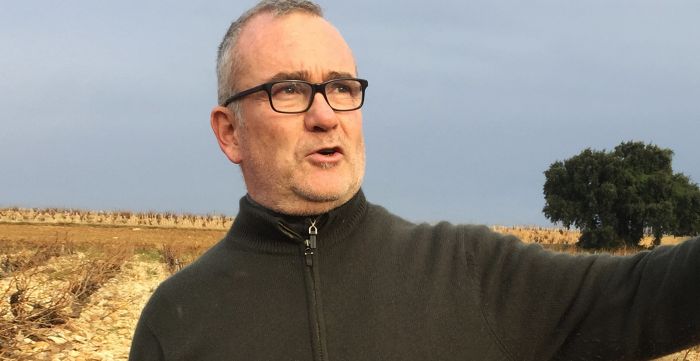
interview
27.06.2019
An Interview with Eric Texier Interview from 2010 (with 2020 updates)
<p><em>This interview with Eric Texier originally stems from a series of emails from October 2010. In April, 2020, revisions were made to update old information.</em></p>
<p><strong>Can you break down the land you currently own?</strong><br />
<br />
We have 4.3 <glossary title="523">ha</glossary> in <span class="zalup"><span><glossary title="204">Brézème</glossary><span>,</span></span></span> on an east bank of <span class="zalup"><span><glossary title="596">limestone</glossary><span>:</span></span></span></p>
<p>2.2 <glossary title="523">ha</glossary> of 15 to 25 year old <glossary title="1001">Syrah</glossary></p>
<p>0.5 ha of <glossary title="1325">Serines</glossary> <glossary title="1001">Syrah</glossary> <glossary title="204">Brézème</glossary> Pergaud (60-70 years) </p>
<p>0.45 ha of <glossary title="878">Roussanne</glossary> planted in 2001 and 2 <glossary title="523">ha</glossary> planted in 2009 and 2018</p>
<p>0.15 ha of <glossary title="878">Roussanne</glossary> <glossary title="204">Brézème</glossary> Pergaud. <br />
<br />
We have 5.5 <glossary title="523">hectares</glossary> in <span class="zalup"><span><glossary title="889">Saint Julien en Saint Alban</glossary><span>,</span></span></span> a west bank of <span class="zalup"><span><glossary title="502">granite</glossary><span>.</span></span></span> The grapes are 50% <span class="zalup"><span><glossary title="1001">Syrah</glossary><span>,</span></span></span> 30% <glossary title="508">Grenache</glossary> and <glossary title="1188">Cinsault</glossary> and 20% <glossary title="297">Clairette</glossary> and <span class="zalup"><span><glossary title="878">Roussanne</glossary><span>.</span></span></span><br />
<br />
<strong>How did you end up making wine?</strong><br />
<br />
Passion. My grandmother had given me some money for my marriage in 1985, and I decided to invest in wine. I began asking around on how to invest this money wisely and began realizing that the wines I enjoyed (Gourgonnier, Chamonard, Trollat, Gentaz, Goyard, Guffens) were a million times more interesting to me than what the specialized press was praising: <span class="zalup"><span><glossary title="178">Bordeaux</glossary><span>,</span></span></span> <span class="zalup"><span><glossary title="579">Languedoc</glossary><span>,</span></span></span> nouveau riche... I got in touch with these <glossary title="1089">vignerons</glossary> and began discovering the concepts and traditions behind their wines. <br />
<br />
I was bored to death at my old job as an engineer in the nuclear industry and quickly opted to learn <glossary title="">viticulture</glossary> and winemaking in 1993 by interning at Guffens. I <glossary title="1104">vinified</glossary> my first wines in 1995 when we moved to <glossary title="">Charnay</glossary> in a house with a wine <glossary title="827">press</glossary> and a <span class="zalup"><span><glossary title="254">cellar</glossary><span>.</span></span></span> <br />
<br />
<strong>Why do you choose to live in the Beaujolais but work in the Rhône?</strong><br />
<br />
I'd been living in the <glossary title="151">Beaujolais</glossary> with my family well before I started making wine. My wife and I moved here when our children were still infants. Alice was born here. The kids call it home here, and I felt that I had no right to force my family to move to the south when this whole wine thing was my idea. <br />
<br />
At first I wanted to settle in <span class="zalup"><span> <glossary title="212">Burgundy</glossary><span>,</span></span></span> find land in <glossary title="370">Côte de Nuits</glossary> or something comparable. Unfortunately I never found anything because of my double handicap of not being a <glossary title="210">Burgundian</glossary> or a millionaire!<br />
<br />
I ended up working with vines in the northern <glossary title="1209">Rhône</glossary> thanks to some friendly advice from guys like Raymond Trollat and Marcel Juge who put me in touch with François Pouchoulin in <span class="zalup"><span><glossary title="204">Brézème</glossary><span>.</span></span></span> I instantly fell in love with this unknown <glossary title="113">appellation</glossary> and the people that had kept it alive; its parallels to <span class="zalup"><span><glossary title="212">Burgundy</glossary><span>,</span></span></span> namely single <glossary title="1071">varietal</glossary> and <glossary title="760">parcel</glossary> specific <span class="zalup"><span><glossary title="185">bottlings</glossary><span>,</span></span></span> sealed the deal for me. But to me, <glossary title="273">Charnay</glossary> is the most beautiful place in the world and that's where I feel most comfortable living. I should also point out that I would never be able to afford a house like mine in the <span class="zalup"><span><glossary title="1063">Val de Drôme</glossary><span>,</span></span></span> an area that is extremely touristic and expensive!<br />
<br />
Finally, I would never find a <glossary title="254">cellar</glossary> as beautiful, as calm and as perfect as my own in <span class="zalup"><span><glossary title="273">Charnay</glossary><span>.</span></span></span><br />
<br />
<strong>What's the work like with the vines? What do you think of your terroirs and your vines?</strong><br />
<br />
<strong><glossary title="260">Certified organic</glossary></strong> "<glossary title="413">Ecocert</glossary>" in <glossary title="204">Brézème</glossary> and <span class="zalup"><span><glossary title="889">Saint Julien</glossary><span>.</span></span></span> We do a lot of experiments involving other types of plants in between rows and vines, as well as "natural" <glossary title="1103">viticulture</glossary> with zero intervention to the soil or the vines (by applying the principles of <span class="zalup"><span><glossary title="1212">Fukuoka</glossary><span>,</span></span></span> Mollison or Altieri). I do my best to never have to use the three things that I find the most intrusive in <glossary title="746">organic</glossary> and <glossary title="160">biodynamic</glossary> <span class="zalup"><span><glossary title="78">agriculture</glossary><span>:</span></span></span></p>
<p> <span class="zalup"><span><span>-</span><glossary title="810">Plowing</glossary> </span></span>(in between rows or at the root)<br />
<span class="zalup"><span><span>-</span><glossary title="333">Copper</glossary> </span></span>(for <glossary title="1137">mildew</glossary>)<br />
<span class="zalup"><span><span>-</span><glossary title="993">Sulfur</glossary> </span></span>(for <glossary title="737">oidium</glossary>)<br />
<br />
To avoid these three pitfalls, I work on cultures that complement each other, selecting plants that provide permanent vegetal cover of the soil that can "shut down" when resources become scarce, by using <glossary title="1210">microbiological</glossary> elements to fight illness (<glossary title="102"></glossary><glossary title="102">Ampelomyces Quiscalis</glossary> and Ascophyllum Nodosum against <span class="zalup"><span><glossary title="737">odium</glossary><span>.</span></span></span>..)<br />
<br />
The <glossary title="1026">terroirs</glossary> of <glossary title="204">Brézème</glossary> and <glossary title="889">Saint Julien</glossary> are particularly unique because wine from either <glossary title="113">appellation</glossary> is very rare: seven producers in <glossary title="204">Brézème</glossary> and three in <glossary title="889">Saint Julien </glossary>(including my son Martin). They are the <glossary title="1026">terroirs</glossary> of farmers, proud of their rusticity and history. <br />
<br />
<strong>At this point, who are you buying grapes from?</strong><br />
<br />
I work exclusively with three <span class="zalup"><span><glossary title="1089">vignerons</glossary><span>:</span></span></span> Jean Riché in <span class="zalup"><span><glossary title="277">Châteauneuf</glossary><span>,</span></span></span> the Deschomets brothers in <glossary title="889">St Julien</glossary> (For "Chat Fou" and "Adèle" fruit) and one in <span class="zalup"><span><glossary title="373">Côte-Rôtie</glossary><span>.</span></span></span> I've known all these guys for a very long time!<br />
<br />
All three of these guys have something in common: they are all better <glossary title="1089">vignerons</glossary> than I am and know their land way better than I do. In fact I'd go as far as to say that these guys taught me everything I know as a <span class="zalup"><span><glossary title="1089">vigneron</glossary><span>.</span></span></span><br />
<br />
Should I <glossary title="810">plow</glossary> along the side of the hill in <glossary title="373">Côte-Rôtie</glossary> in August when storms are announced in early September? I don't know since I don't have to worry about stuff like this in <span class="zalup"><span><glossary title="204">Brézème</glossary><span>,</span></span></span> where my soils there "behave" better. <br />
<br />
Or do I take a big risk in <glossary title="277">Châteauneuf</glossary> by letting grass grow under the rows in a rainy vintage? Again, I have Jean who always does the right thing because of his experience with his <glossary title="1026">terroirs</glossary> and vines. <br />
<br />
What I've learned in <glossary title="204">Brézème</glossary> only applies to <glossary title="204">Brézème</glossary>; I can't transpose my work there to <glossary title="889">Saint Julien</glossary> because the <glossary title="1026">terroirs</glossary> and the climate are very different. In such, I learn from the proprietors that worked this land before I did. <br />
<br />
I work with these three guys because they are great <span class="zalup"><span><glossary title="1089">vignerons</glossary><span>.</span></span></span> They are autonomous and traditionalists (no <span class="zalup"><span><glossary title="543">insecticides</glossary><span>,</span></span></span> <glossary title="810">plowing</glossary> soils, letting grass grow) and I have nothing to explain to them. <br />
<br />
I laugh when I hear people sourcing fruit tell me they control everything the <glossary title="1089">vigneron</glossary> does in the vineyard:</p>
<p>1) You're clearly full of it unless you live and sleep in the vines every night.</p>
<p>2) If you're telling someone how to do his job and he offers zero input and does exactly what you say, I don't see how this can be beneficial to the work being done in the vineyard. <br />
<br />
So my basic principle remains the same: I don't give any orders to my <glossary title="1089">vignerons</glossary> and I control absolutely nothing! They are my friends and I have total confidence in them. Not to mention they all have superb <glossary title="1026">terroirs</glossary> with the least amount of <glossary title="304">clones</glossary> possible (I'm at about 95% old vines or <glossary title="941">massale</glossary>) and as many <glossary title="740">old vines</glossary> as possible.<br />
<br />
<strong>What's the wine making process like?</strong><br />
<br />
For red:</p>
<p>-no intervention during <span class="zalup"><span><glossary title="1104">vinification</glossary><span>:</span></span></span> no <span class="zalup"><span><glossary title="321">yeasting</glossary><span>,</span></span></span> no <span class="zalup"><span><glossary title="993">SO2</glossary><span>,</span></span></span> no bacteria, no <span class="zalup"><span><glossary title="1010">tannins</glossary><span>,</span></span></span> no <glossary title="423">enzymes</glossary></p>
<p>-no <span class="zalup"><span><glossary title="795">pigeages</glossary><span>:</span></span></span> the <glossary title="234">hat</glossary> stays forcefully immersed thanks to a wood clamp</p>
<p>- Short <span class="zalup"><span><glossary title="610">cuvaisons</glossary><span>,</span></span></span> 5 to 10 days mostly</p>
<p>- <glossary title="74">Aged</glossary> on the <span class="zalup"><span><glossary title="590">lees</glossary><span>,</span></span></span> no <glossary title="993">SO2</glossary> unless necessary, no <span class="zalup"><span><glossary title="717">new oak</glossary><span>,</span></span></span> 20% small <span class="zalup"><span><glossary title="142">barrels</glossary><span>,</span></span></span> 30% <glossary title="1126">wood</glossary> <glossary title="1140">tanks</glossary> and 50% <glossary title="325">cement</glossary> <glossary title="1140">tanks</glossary></p>
<p>- Very little <glossary title="447">filtration</glossary> (less than 10% on normal years, bottled when the wine is clear)</p>
<p>- 10 to 30 mg of <glossary title="993">SO2</glossary> at <span class="zalup"><span> <glossary title="185">bottling</glossary><span>.</span></span></span> I do a few <glossary title="363">cuvées</glossary> with <span class="zalup"><span><glossary title="913">no SO2</glossary><span>:</span></span></span> an improbable <span class="zalup"><span><glossary title="277">Châteauneuf-du-Pape</glossary><span>,</span></span></span> one <glossary title="185">bottling</glossary> of Pergaud <glossary title="889">Saint Julien</glossary> as well as the Pergaud <glossary title="204">Brézème</glossary><br />
<br />
For white:</p>
<p> <span class="zalup"><span><span>-</span><glossary title="811">Pneumatic press</glossary> </span></span>or <glossary title="1085">vertical</glossary> <glossary title="827">press</glossary> without <glossary title="610">maceration</glossary> except for certain <glossary title="363">cuvées</glossary> <glossary title="185">bottled</glossary> <glossary title="913">without SO2</glossary></p>
<p>-No intervention during <span class="zalup"><span><glossary title="1104">vinification</glossary><span>:</span></span></span> no <span class="zalup"><span><glossary title="321">yeasting</glossary><span>,</span></span></span> no <span class="zalup"><span><glossary title="993">SO2</glossary><span>,</span></span></span> no bacteria, no <span class="zalup"><span><glossary title="1010">tannins</glossary><span>,</span></span></span> no <glossary title="423">enzymes</glossary></p>
<p>- <glossary title="74">Aged</glossary> on the <span class="zalup"><span><glossary title="590">lees</glossary><span>,</span></span></span> no <glossary title="993">SO2</glossary> unless necessary, no <span class="zalup"><span><glossary title="717">new oak</glossary><span>,</span></span></span> 50% <glossary title="1126">wood</glossary> <glossary title="142">barrels</glossary> and 50% <glossary title="325">cement</glossary> <glossary title="1140">tanks</glossary></p>
<p>- <glossary title="447">Filtered</glossary> "sur terre" except for the "Pergaud" and <glossary title="277">Châteauneuf Blanc</glossary></p>
<p>- 20 to 40 mg of <glossary title="993">SO2</glossary> at <glossary title="185">bottling</glossary></p>
<p>My wines are not meant to be "nice" or "fun". They can be, like "Chat Fou"<em> </em>or "Adèle". But I believe they express where they come from and truly show a sense of regional identity. They are clear and precise. I don't give a shit what people are drinking at hipster wine bars in Paris or what a 1000 euro bottle of <glossary title="178">Bordeaux</glossary> tastes like. I'm also very happy people like my grandma and François Pouchoulin, the father of <span class="zalup"><span><glossary title="204">Brézème</glossary><span>,</span></span></span> like them. <br />
<br />
<strong>What do you think of the wines of your AOC and how they compare to something "typical" of the region?</strong><br />
<br />
I'm in the "Terroiriste" camp, <glossary title="558">Jules Chauvet</glossary> style. I don't like modern wines or super <glossary title="708">natural wines</glossary> that scream "fuck tradition".</p>
<p>I'll let Jules do the talking: "Every <glossary title="1089">vigneron</glossary> should accept his wines as they are in reality, and not how he wants them to be."<br />
<br />
<strong>What kind of wines are you aiming to make?</strong><br />
<br />
Wines of <span class="zalup"><span><glossary title="1026">terroir</glossary><span>.</span></span></span><br />
<br />
<strong>Have you always worked organically?</strong><br />
<br />
Yes. <br />
<br />
<strong>Why?</strong><br />
<br />
For me it comes right back to <span class="zalup"><span><glossary title="558">Chauvet</glossary><span>.</span></span></span> <br />
<br />
The less you interfere with the vines and during the winemaking process the more your wine stays true to its origin, whether it be <span class="zalup"><span><glossary title="1026">terroir</glossary><span>,</span></span></span> <glossary title="1071">varietal</glossary> or <span class="zalup"><span><glossary title="1109">vintage</glossary><span>.</span></span></span> In such you can be proud of its unique individuality. <br />
<br />
<strong>Where do you stand on the natural wine debate? </strong><br />
<br />
If "natural" essentially means a product of nature then long live <span class="zalup"><span><glossary title="708">natural wine</glossary><span>!</span></span></span> On the other hand, if "natural" means disjointed, revolutionary and trying to justify all possible deviation for the sake of originality, then I'd rather make wines like that than actually drink them...<br />
<br />
Modern wines and super <glossary title="708">natural wines</glossary> share a common trait: the will of the <glossary title="1089">vigneron</glossary>/winemaker to make a wine knowing precisely what he wants from it. This idea frustrates me because I feel it leads to a standardization of taste. An overripe <glossary title="217">Cabernet</glossary> with a ton of new <glossary title="1126">wood</glossary> doesn't strike me as better or worst than a <glossary title="236">carbonic</glossary> <glossary title="1001">Syrah</glossary> that tastes like every other <glossary title="236">carbonic</glossary> wine ever made. If I had to pick one of the two though, needless to say I'd drink the latter!!!<br />
<br />
<strong>What wines do you like to drink besides your own?</strong><br />
<br />
-Chamonard's <glossary title="685">Morgon</glossary> </p>
<p>-Mas du Gourgonier</p>
<p>-Frank Peillot's <span class="zalup"><span><glossary title="96">Altesses</glossary></span></span></p>
<p>-Marc Olliver's <glossary title="697">Muscadets</glossary></p>
<p>-Some classic <span class="zalup"><span><glossary title="">Burgundy</glossary><span>:</span></span></span> Rousseau, Roumier, Mugneret Gibourg and DRC</p>
<p>-The old <glossary title="1001">Syrahs</glossary> of Trollat, Gentaz Dervieux, Juge or Verset</p>
<p>-Les Ponchonières d’Helen Durant in <glossary title="845">Rasteau</glossary></p>
<p>And way too many Italian wines: (Fonterenza, Montesecondo, Foradori, Monte Dall'Ora, Cascina Corte, Aldo Viola, Rinaldi...) </p>
Article
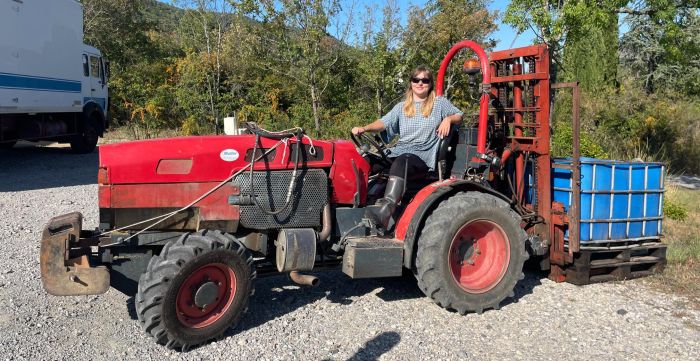
harvest report
04.01.2023
2023 Harvest Report from Laurence Texier
<p><strong>November 15th, 2023:</strong></p>
<p>Despite being a challenging year in the vines, the 2023 <glossary term="Vintage" title="1109">vintage</glossary> has provided us an excellent crop, both in quantity and quality. We had to be very attentive throughout the spring and summer as <glossary term="Mildew" title="1137">mildew</glossary> pressure was very high. Constant episodes of rain, while insufficient in terms of the water needed for the vines, kept us on our toes through mid-July. In the end, only 10 to 15% of the crop was lost to <span class="zalup"><span><glossary term="Oidium" title="737">black rot</glossary><span>.</span></span></span></p>
<p>Unfortunately, our <glossary term="Roussanne" title="878">Roussanne</glossary> vines suffered tremendously from a heat wave in late August. For the fifth consecutive year, we were only able to <glossary term="Harvest" title="521">harvest</glossary> a micro-crop of the white grapes in <span class="zalup"><span><glossary term="Brézème" title="204">Brézème</glossary><span>.</span></span></span></p>
<p>In the end, we’re still very happy with the 2023 <span class="zalup"><span><glossary term="Vintage" title="1109">vintage</glossary><span>,</span></span></span> memorable as our biggest since growing our own vines and one of the best relative to the cultivated surface. We can thank the heavens for sending us 80 mm of rain just after the heatwave of August. In our estimation, this rain increased <glossary term="Yield" title="1129">yields</glossary> by almost 30%. This goes to show that sometimes nature IS on our side. As in 2022, we're reminded our work is highly dependent on the weather. The coming years will undoubtedly be increasingly marked by weather extremes. </p>
<p><glossary term="Vinification" title="1104">Vinifications</glossary> went very well in 2023 and we are happy to already announce some very fine <glossary term="Cuvée" title="363">cuvées</glossary> for this <span class="zalup"><span><glossary term="Vintage" title="1109">vintage</glossary><span>.</span></span></span></p>
<p><img src="https://louisdressner.com/uploads/images/article//1003/b1/24/b124373dd4731a52febc2451f03304e8.jpg" /><img src="https://louisdressner.com/uploads/images/article//1003/3f/83/3f836872bd03b601e3928643d36d23c2.jpg" /><img src="https://louisdressner.com/uploads/images/article//1003/8a/c1/8ac11ee14fd2e2d6378c4bcfc53b088d.jpg" /><img src="https://louisdressner.com/uploads/images/article//1003/78/34/78342ef0e1d77e0a10567dc18ad9ff92.jpg" /><img src="https://louisdressner.com/uploads/images/article//1003/f6/54/f65441d64e794f3f9b80b5207e8ee76d.jpg" /><img src="https://louisdressner.com/uploads/images/article//1003/7d/ac/7dac8a2c493dcbc801b6b9a4f70964c4.jpg" /><img src="https://louisdressner.com/uploads/images/article//1003/98/91/98914e6e35a02b2c7e47c45917012b31.jpg" /><img src="https://louisdressner.com/uploads/images/article//1003/62/f8/62f83ae1421dab7fc0ba201a3649e522.jpg" /><img src="https://louisdressner.com/uploads/images/article//1003/16/4a/164a50ed8e799a8caad8449b82c88e3d.jpg" /><img src="https://louisdressner.com/uploads/images/article//1003/d1/69/d1693b372cd5797af8003a017f107630.jpg" /><img src="https://louisdressner.com/uploads/images/article//1003/aa/40/aa400ba338bf6022916f3848dcc66c6b.jpg" /><img src="https://louisdressner.com/uploads/images/article//1003/3d/34/3d340f595f5eb28582f95adc52a3beee.jpg" /><img src="https://louisdressner.com/uploads/images/article//1003/06/54/065427495c9827780de9bb0aeafcffc4.jpg" /><img src="https://louisdressner.com/uploads/images/article//1003/7b/a9/7ba97f9edaac89a04632ac22dabf36cb.jpg" /><img src="https://louisdressner.com/uploads/images/article//1003/35/3d/353d089663433b666657e464324c0f6a.jpg" /><img src="https://louisdressner.com/uploads/images/article//1003/55/d5/55d5ef5f87329535f5f3b3fa3def7b26.jpg" /><img src="https://louisdressner.com/uploads/images/article//1003/ff/9e/ff9e651a57c9834f42b9bd149081d69e.jpg" /><img src="https://louisdressner.com/uploads/images/article//1003/bf/35/bf353a97e36a95e623fcb67ab719f1f9.jpg" /><img src="https://louisdressner.com/uploads/images/article//1003/85/c2/85c29848bd95e4dabec96e694524fc95.jpg" /><img src="https://louisdressner.com/uploads/images/article//1003/b0/4f/b04fc50949ca424073ce8c62889659f9.jpg" /><img src="https://louisdressner.com/uploads/images/article//1003/7b/19/7b19c19bdb478814a9e0fc0753fe5ed7.jpg" /><img src="https://louisdressner.com/uploads/images/article//1003/dd/e2/dde2759643e07e7f8f7efae610a690ef.jpg" /><img src="https://louisdressner.com/uploads/images/article//1003/e0/29/e029c28790efafa034e86ac5db6f61fd.jpg" /></p>
Article
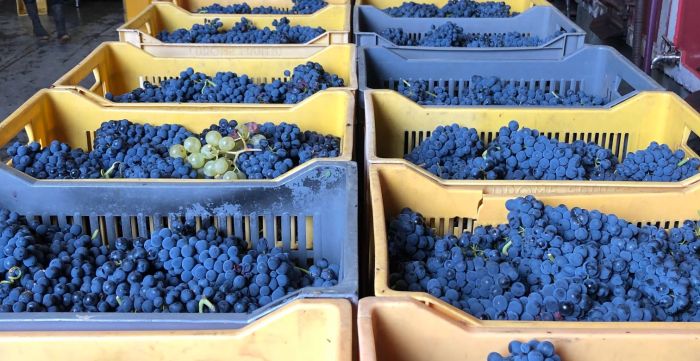
harvest report
02.01.2022
2022 Harvest Report from Eric Texier
<p>Another year that defied expectations! At the end of July, we were fairly certain the extreme heat and <span class="zalup"><span><glossary term="Drought" title="1167">drought</glossary><span>,</span></span></span> a continued and devastating effect of climate change, would cost us our <glossary term="Harvest" title="521">harvest</glossary> as the vines would shut down to go into survival mode. This led to a procession of questions: did we make the correct choices when working the soils, the grape varieties we replanted and continue to farm, our refusal to resort to <span class="zalup"><span><glossary term="Irrigation" title="549">irrigation</glossary><span>?</span></span></span></p>
<p>The <glossary term="Cinsault" title="1188">Cinsaults</glossary> and the very <glossary term="Old Vines" title="740">old vines</glossary> seemed to be the only ones in measure to produce grapes for us. But as is often the case, Vitis Vinifera showed us its incredible resistance: two perfect rains on August 16th and 29th, not too violent or too fast, totally changed the course of the <span class="zalup"><span><glossary term="Vintage" title="1109">vintage</glossary><span>.</span></span></span> The vines restarted their vegetative cycle, became healthy again and provided us a magnificent <span class="zalup"><span> <glossary term="Harvest" title="521">harvest</glossary><span>,</span></span></span> balanced and qualitative. The wines are in the same vein as 2020 or 2018, full of fruit with a septentrional structure and no traces of the over<span class="zalup"><span><span>-</span><glossary term="Maturation" title="639">maturity</glossary> </span></span>we were worried about.</p>
<p><img src="https://louisdressner.com/uploads/images/article//969/0e/ae/0eaee6007838adbd74147d8ae6147874.jpg" /><img src="https://louisdressner.com/uploads/images/article//969/70/8d/708d6ee5be7c710c648d3a1003fc730b.jpg" /><img src="https://louisdressner.com/uploads/images/article//969/5b/f6/5bf6b8b5c4a515fdc491147a4e0f4af1.jpg" /><img src="https://louisdressner.com/uploads/images/article//969/85/64/8564cc74e08eeac05cbf0ef9db62c95f.jpg" /><img src="https://louisdressner.com/uploads/images/article//969/8b/0e/8b0ef36336269cac231992eb7ac8cc72.jpg" /><img src="https://louisdressner.com/uploads/images/article//969/a8/c4/a8c4ae40da8c15b5f379e7d285ab72f9.jpg" /><img src="https://louisdressner.com/uploads/images/article//969/8a/e7/8ae70f0598215c778f90a9bdef101264.jpg" /><img src="https://louisdressner.com/uploads/images/article//969/98/ef/98efea09227e31191dbcd02f111a530a.jpg" /><img src="https://louisdressner.com/uploads/images/article//969/8b/7d/8b7d63dfa3e8712dd95ba1736c0ad759.jpg" /><img src="https://louisdressner.com/uploads/images/article//969/7c/e9/7ce984305a65e7bc23f7f58b25c1e7b1.jpg" /><img src="https://louisdressner.com/uploads/images/article//969/68/84/6884227d1eee51fec6a207064cc2bf9d.jpg" /><img src="https://louisdressner.com/uploads/images/article//969/0b/84/0b84f78e53f8c09befe121f13c870cc8.jpg" /></p>
Article
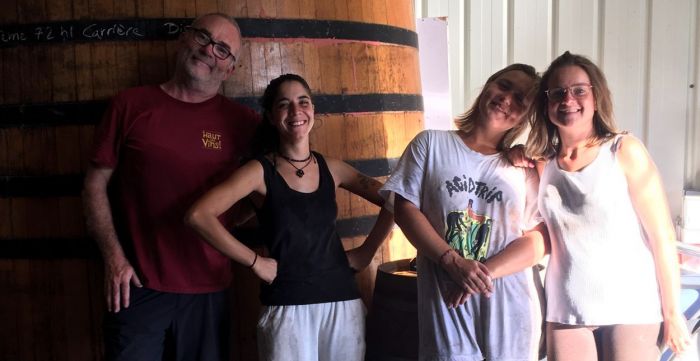
harvest report
20.01.2020
2020 Harvest Report from Eric Texier
<p><u><strong>November 20th, 2020:</strong></u></p>
<p>After a very mild winter (too mild), the rest of the 2020 season was quite smooth. We got the water we needed in the spring, very little pressure from illness and no brutal heatwave, though it was a very hot and dry summer. A nice 40mm rain in August let the grapes plump up and continue ripening without stress. </p>
<p>As has become the norm here, started with the <glossary term="Chasselas" title="276">Chasselas</glossary> and <glossary term="Muscat" title="698">Muscats</glossary> for the <glossary term="Pétillant Naturel" title="778">pétillant naturel</glossary> on August 13th. The next day, we were picking <glossary term="Roussanne" title="878">Roussannes</glossary> from the La Carrière <glossary term="Parcel" title="760">parcel</glossary> in <span class="zalup"><span><glossary term="Brézème" title="204">Brézème</glossary><span>.</span></span></span> This very steep <span class="zalup"><span><glossary term="Parcel" title="760">parcel</glossary><span>,</span></span></span> <glossary term="Exposition" title="430">exposed</glossary> full south and very rocky, suffered from the heat; the grapes were already very ripe, even showing signs of <span class="zalup"><span><glossary term="Passerillage" title="763">passerillage</glossary><span>.</span></span></span> So tiny <glossary term="Yield" title="1129">yields</glossary> there, but very nice <glossary term="Acidity" title="71">acidity</glossary> nonetheless.</p>
<p>Rain then swept in, so we took a ten day break before jumping back in with the full team. This motley crew included a jolly team of urban artists, locals, some who had travelled from other countries, alternative militants and <glossary term="Ardèche" title="117">Ardéchoix</glossary> <span class="zalup"><span><glossary term="Peasant" title="769">peasants</glossary><span>.</span></span></span> Martin and Patrice headed the group, and we got the entire <glossary term="Harvest" title="521">harvest</glossary> into the <glossary term="Cellar" title="254">cellar</glossary> in 10 days time, always under a nice sun that wasn’t too hot. We were pleasantly surprised by the quantities, which are higher than we’d initially expected. </p>
<p>In the end it was a nice haul, a tiny bit less than 2019 and much more than 2017 and 2018. There wasn’t a single berry to throw out, the <glossary term="Fermentation" title="441">fermentations</glossary> were quick and precise: no headaches for Alice and Eric in the <span class="zalup"><span><glossary term="Vat/Tank" title="1140">vats</glossary><span>.</span></span></span> The <glossary term="alcoholic potential" title="1381">potentials</glossary> are not too high and the wines are balanced, particularly in <glossary term="Saint-Julien-en-Saint-Alban" title="889">Saint-Julien</glossary> where we always worry that the <glossary term="Granite" title="502">granites</glossary> will make <glossary term="Maturation" title="639">maturities</glossary> rise too quickly. We also got some magnificent <glossary term="Cinsault" title="1188">Cinsault</glossary> in the Preyna that will go to Alice for her "Pivois" <span class="zalup"><span><glossary term="Cuvée" title="363">cuvée</glossary><span>,</span></span></span> Martin’s <glossary term="Cinsault" title="1188">Cinsault</glossary> and our "Chat Fou". </p>
<p>"Le Clau" will be a deep wine and <glossary term="Brézème" title="204">Brézème</glossary>’s and <glossary term="Saint-Julien-en-Saint-Alban" title="889">Saint-Julien</glossary>’s <glossary term="Syrah" title="1001">Syrahs</glossary> will be fairly similar to 2010.</p>
<p><img src="https://louisdressner.com/uploads/images/article//874/f5/90/f5906f489e0a5723c502da25f11e957c.jpg" /><img src="https://louisdressner.com/uploads/images/article//874/1e/ee/1eeeec3c5b6e2851db8d52533b603b0b.jpg" /><img src="https://louisdressner.com/uploads/images/article//874/40/06/40065ee69b77ef456616e1715716bc81.jpg" /><img src="https://louisdressner.com/uploads/images/article//874/34/b9/34b960541db04df05a7973bd51ed2850.jpg" /><img src="https://louisdressner.com/uploads/images/article//874/6a/53/6a53b6d317462cc30618b6b9d478ab31.jpg" /><img src="https://louisdressner.com/uploads/images/article//874/3e/3a/3e3af6d6ea33daa5665175c98c0104ca.jpg" /><img src="https://louisdressner.com/uploads/images/article//874/85/a1/85a17b6b855c067a7660ddd5fec011de.jpg" /><img src="https://louisdressner.com/uploads/images/article//874/20/35/2035aaffe5579d549dc38ffd6e88aa8c.jpg" /><img src="https://louisdressner.com/uploads/images/article//874/e8/bf/e8bf596291fccfa999b46eaef6f62b5b.jpg" /><img src="https://louisdressner.com/uploads/images/article//874/88/4a/884a4f1cf36a905018bfe26a8dceef72.jpg" /><img src="https://louisdressner.com/uploads/images/article//874/8e/ed/8eed93d9759c23f989ec4382c82c3b54.jpg" /><img src="https://louisdressner.com/uploads/images/article//874/b0/7b/b07b81417ba05ec00072d93d31870640.jpg" /><img src="https://louisdressner.com/uploads/images/article//874/64/de/64de396cdadb063f941b5b1049caba32.jpg" /><img src="https://louisdressner.com/uploads/images/article//874/18/85/18855fb6c5b34ca380ad26add23216b3.jpg" /><img src="https://louisdressner.com/uploads/images/article//874/04/d1/04d17c0cb60e49781147948f6ee3ab67.jpg" /><img src="https://louisdressner.com/uploads/images/article//874/73/27/732734806bf6f263c6cb9fdd498cfcf3.jpg" /><img src="https://louisdressner.com/uploads/images/article//874/f6/53/f65385ec990991f47af3770a4db9482f.jpg" /><img src="https://louisdressner.com/uploads/images/article//874/1b/70/1b7078a1c8e09b19bbaee60b7a062a40.jpg" /><img src="https://louisdressner.com/uploads/images/article//874/3c/c3/3cc32b5bb7f2a3350ef05d8c849e2d52.jpg" /><img src="https://louisdressner.com/uploads/images/article//874/18/77/1877432a2559da6a718422ce163e5199.jpg" /><img src="https://louisdressner.com/uploads/images/article//874/61/d8/61d82754ecdc4145eb6902289f59dd66.jpg" /></p>
Article
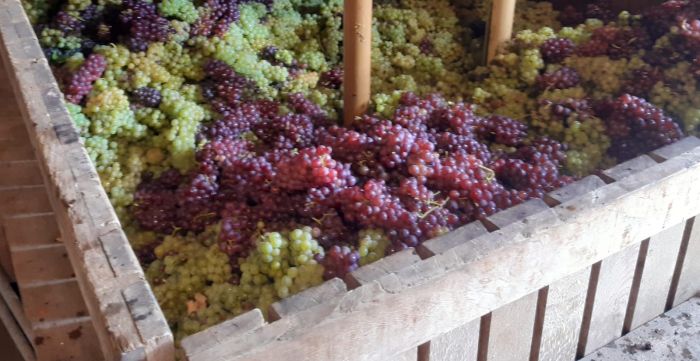
harvest report
06.10.2019
2019 Harvest Report from Laurence Texier
<p><u><strong>October 4th, 2019:</strong></u></p>
<p>The scoop in 2019:</p>
<p>After the heatwave of June and July an intense <span class="zalup"><span><glossary term="Drought" title="1167">drought</glossary><span>,</span></span></span> we were anticipating a small crop similar to 2017. By late August, there was still no rain. </p>
<p>The quick and unexpected <glossary term="Maturation" title="639">maturities</glossary> of the <glossary term="Roussanne" title="878">Roussannes</glossary> made us pick very quickly in <glossary term="Brézème" title="204">Brézème</glossary> and our worries were confirmed: the grapes were withered and the sugar levels were very high, though the <glossary term="Acidity" title="71">acidity</glossary> was there. After picking a a measly 2<span class="zalup"><span>0<glossary term="hl/ha" title="528">hl/ha</glossary><span>,</span></span></span> morale was not high. We decided we had to work in overdrive to <glossary term="Harvest" title="521">harvest</glossary> everything as quickly as possible before it burned. </p>
<p>We picked the first reds in <glossary term="Saint-Julien-en-Saint-Alban" title="889">Saint-Julien</glossary> on September 5th, starting with the <glossary term="Grenache" title="508">Grenaches</glossary> from l’Hôpital. A good surprise: this sector had fared much better: lots of grapes, perfectly healthy with reasonable <glossary term="Maturation" title="639">maturities</glossary> and good <span class="zalup"><span><glossary term="Acidity" title="71">acidity</glossary><span>.</span></span></span> The result will be a more “northern” "Chat Fou" then the last two <span class="zalup"><span><glossary term="Vintage" title="1109">vintages</glossary><span>.</span></span></span> The <glossary term="Syrah" title="1001">Syrahs</glossary> were just as good.</p>
<p>In the <span class="zalup"><span><glossary term="Cellar" title="254">cellar</glossary><span>,</span></span></span> we started tallying our <glossary term="Saint-Julien-en-Saint-Alban" title="889">Saint-Julien</glossary> <span class="zalup"><span><glossary term="Harvest" title="521">harvest</glossary><span>:</span></span></span> there are way more grapes than we expected and they are magnificent. The temperature was still very hot, forcing us to <glossary term="Harvest" title="521">harvest</glossary> only in the morning. But morale is back. Even the <glossary term="Serine" title="1325">Serines</glossary> of Le Clau are generous. It’s starting to feel really good…</p>
<p>On the 11th, we head back to the <glossary term="Drôme" title="407">Drôme</glossary> to <glossary term="Harvest" title="521">harvest</glossary> <span class="zalup"><span><glossary term="Brézème" title="204">Brézème</glossary><span>,</span></span></span> and it’s abundant. The <glossary term="Maturation" title="639">maturities</glossary> are similar to 2009 and the <glossary term="Yield" title="1129">yields</glossary> much higher. We decided to leave almost everything <glossary term="Whole-Cluster" title="1124">whole-cluster</glossary> and minimize the <glossary term="Maceration" title="610">macerations</glossary> between five to eight days. The colors are intense, the <glossary term="Fermentation" title="441">fermentations</glossary> are going well and the juices seem very pure. </p>
<p>Nature has surprised and awed us. We really did not see this coming. The work is very intense in the vines and in the <span class="zalup"><span> <glossary term="Cellar" title="254">cellar</glossary><span>,</span></span></span> we can barely move at the end of the day but all have a big smile. </p>
<p>We ended with the <glossary term="Cinsault" title="1188">Cinsaults</glossary> of <span class="zalup"><span><glossary term="Saint-Julien-en-Saint-Alban" title="889">Saint-Julien</glossary><span>:</span></span></span> low <glossary term="alcoholic potential" title="1381">potential</glossary> of 12%, magnificent grapes and promising juices. <span class="zalup"><span><glossary term="Cinsault" title="1188">Cinsault</glossary><span>,</span></span></span> along with <span class="zalup"><span><glossary term="Clairette" title="297">Clairette</glossary><span>,</span></span></span> is the grape thriving in the increasingly extreme conditions imposed by climate change. <glossary term="Cinsault" title="1188">Cinsault</glossary> will also be a new addition to “Chat Fou”, consisting of 25% to 30% of the <glossary term="Blend" title="168">blend</glossary> this year (and maybe in the future). It’s looking like a lot of picking <glossary term="Selection Massale" title="941">selections massales</glossary> and doing a lot of our own <glossary term="Grafting" title="500">grafts</glossary> and plantings coming years!</p>
<p><img src="http://louisdressner.com/uploads/images/article/2020_Oct_06//5c/9b/5c9b3407fb2630dfc73bb16da6f87b88.jpg" /><img src="http://louisdressner.com/uploads/images/article/2020_Oct_06//b7/6a/b76a7e48b5180ba841b1704860d1d743.jpg" /><img src="http://louisdressner.com/uploads/images/article/2020_Oct_06//e6/7e/e67e70d71d41017bece3c54f98111c26.jpg" /><img src="http://louisdressner.com/uploads/images/article/2020_Oct_06//5f/35/5f35f3a8c41a2aa3a6a5b47c338854e3.jpg" /><img src="http://louisdressner.com/uploads/images/article/2020_Oct_06//d3/73/d373ffcaee9039e1f42f71a116c1354b.jpg" /><img src="http://louisdressner.com/uploads/images/article/2020_Oct_06//66/c0/66c0cd8627d859a44299d668451507f9.jpg" /><img src="http://louisdressner.com/uploads/images/article/2020_Oct_06//89/2e/892e0283f28bf982b31349ff6e6605b5.jpg" /><img src="http://louisdressner.com/uploads/images/article/2020_Oct_06//2f/82/2f8265a25d71cfa963be6bb76aaa8d57.jpg" /><img src="http://louisdressner.com/uploads/images/article/2020_Oct_06//03/69/0369fb2e57307115ab61e145763c36b0.jpg" /><img src="http://louisdressner.com/uploads/images/article/2020_Oct_06//6d/26/6d2623a4d3578535af5a754cb4040942.jpg" /><img src="http://louisdressner.com/uploads/images/article/2020_Oct_06//bc/5c/bc5c8d4a57d07e194672ae69149ee441.jpg" /><img src="http://louisdressner.com/uploads/images/article/2020_Oct_06//1b/a3/1ba3b277f0aaf48505152d44b44e369f.jpg" /><img src="http://louisdressner.com/uploads/images/article/2020_Oct_06//22/66/22668aad7e4a0ed546afaa52fe3cd8c7.jpg" /><img src="http://louisdressner.com/uploads/images/article/2020_Oct_06//26/68/2668d349fc523287886a88a9a69ebb45.jpg" /><img src="http://louisdressner.com/uploads/images/article/2020_Oct_06//a9/60/a9609f2886fee1b5bf684c1b1eb9cb14.jpg" /><img src="http://louisdressner.com/uploads/images/article/2020_Oct_06//4b/ba/4bbafd68bf60809b263c1d8241efdaeb.jpg" /><img src="http://louisdressner.com/uploads/images/article/2020_Oct_06//ca/3e/ca3eaff06bd3fdb2fada730e1ce1e388.jpg" /><img src="http://louisdressner.com/uploads/images/article/2020_Oct_06//ce/34/ce34c8f050a5a5216051dc3d8c993e4d.jpg" /><img src="http://louisdressner.com/uploads/images/article/2020_Oct_06//81/10/81103e13c78bc9f0e4a3136d414507d6.jpg" /><img src="http://louisdressner.com/uploads/images/article/2020_Oct_06//6b/84/6b84945b5a83f56de69059508b6a9c3e.jpg" /><img src="http://louisdressner.com/uploads/images/article/2020_Oct_06//0d/fb/0dfb3dd7b5c67928f1b517e930a82f28.jpg" /><img src="http://louisdressner.com/uploads/images/article/2020_Oct_06//59/6f/596fffbc06780c4be901de127990854f.jpg" /><img src="http://louisdressner.com/uploads/images/article/2020_Oct_06//53/d6/53d64f233d8b37cd26886f5255858ce8.jpg" /><img src="http://louisdressner.com/uploads/images/article/2020_Oct_06//7d/4a/7d4ac00e4ea618559446810f70b923d2.jpg" /><img src="http://louisdressner.com/uploads/images/article/2020_Oct_06//f7/ab/f7ab1175d1cab590f418bb945000faa3.jpg" /><img src="http://louisdressner.com/uploads/images/article/2020_Oct_06//84/51/84511d15467a4d776d667297a3aa799a.jpg" /><img src="http://louisdressner.com/uploads/images/article/2020_Oct_06//6f/f4/6ff454a7ea68d00e5da9d3501ce85990.jpg" /><img src="http://louisdressner.com/uploads/images/article/2020_Oct_06//e9/9a/e99af07cac9a4cbf82a1cd271223ef0b.jpg" /><img src="http://louisdressner.com/uploads/images/article/2020_Oct_06//57/39/573991826b1e01f12407896748a95ea1.jpg" /><img src="http://louisdressner.com/uploads/images/article/2020_Oct_06//fe/28/fe2868acadec7e3c0cf1067ab05543e6.jpg" /><img src="http://louisdressner.com/uploads/images/article/2020_Oct_06//4f/97/4f97e28bd3ace5c3a9bdaf0e51341344.jpg" /><img src="http://louisdressner.com/uploads/images/article/2020_Oct_06//9c/22/9c2242f588318f3db5e0f4fb40af3425.jpg" /></p>
Article
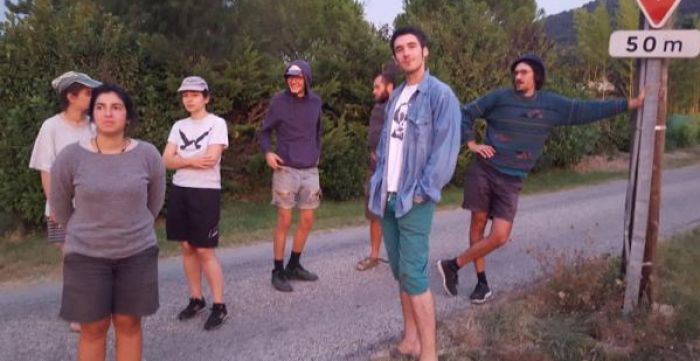
harvest report
09.11.2016
2016 Harvest Photos from Eric Texier
<p><img src="http://louisdressner.com/uploads/images/article/2019_Sep_18//f5/c7/f5c72f3707b2516c0171f594778a1745.jpg" /></p>
<p><img src="http://louisdressner.com/uploads/images/article/2019_Sep_18//97/df/97df289a3a4a4bf05c393b2fb6a04d27.jpg" /></p>
<p><img src="http://louisdressner.com/uploads/images/article/2019_Sep_18//15/c4/15c43d3cdee7db7350ce1b0e130f1663.jpg" /></p>
<p><img src="http://louisdressner.com/uploads/images/article/2019_Sep_18//94/e0/94e099ed6616be420a37d86a68ce641c.jpg" /></p>
<p><img src="http://louisdressner.com/uploads/images/article/2019_Sep_18//52/72/5272ffec4ba30360abd4b18855b46852.jpg" /></p>
<p><img src="http://louisdressner.com/uploads/images/article/2019_Sep_18//03/5f/035fcf8a8cf8578225b988d524aed77d.jpg" /></p>
<p><img src="http://louisdressner.com/uploads/images/article/2019_Sep_18//6f/4e/6f4ede42c21a58f52b0ead6bf85214e8.jpg" /></p>
<p><img src="http://louisdressner.com/uploads/images/article/2019_Sep_18//8d/b4/8db4654f6e2de0886177a80dbed63fb9.jpg" /></p>
<p> </p>
Article
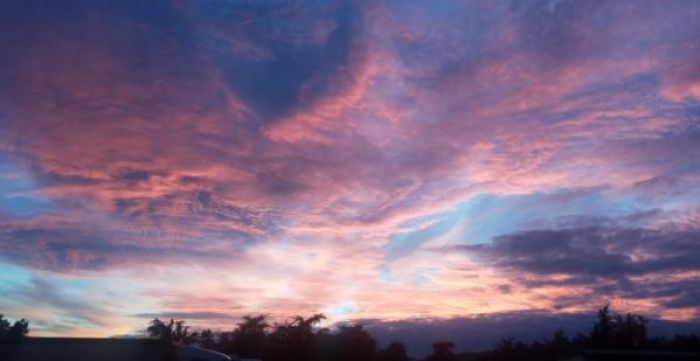
harvest report
11.11.2015
2015 Harvest Report from Eric Texier
<p>Voilà!<br />
<br />
It's September 17th and the wines are finished and in their respective <glossary title="74">aging</glossary> <span class="zalup"><span><glossary title="1160">vessels</glossary><span>.</span></span></span> This would have been inconceivable 15 years ago. Whether it truly is climate change or just exceptional weather, 2015 has marked us as an unforgettable year. In the Northern <span class="zalup"><span><glossary title="1209">Rhône</glossary><span>,</span></span></span> everything worked out perfectly: no sanitary issues and none of the negative impacts of a heat wave like 2003. With the exception of some <glossary title="737">black rot</glossary> in <glossary title="889">Saint Julien</glossary>'s <span class="zalup"><span><glossary title="508">Grenache</glossary><span>,</span></span></span> everything was perfect.<br />
<br />
There was very little rain in 2015, but just enough to relieve the vines. There was sun but also cool nights. The heat wave in no way negatively affected <glossary title="276">Chasselas</glossary> picked on August 18th by our son Martin, who will continue making the bubbles on his own this year. We followed with the <glossary title="878">Roussanne</glossary> on the <glossary title="345">coteau</glossary> of <span class="zalup"><span><glossary title="204">Brézème</glossary><span>,</span></span></span> the old <glossary title="634">Marsanne</glossary> in <span class="zalup"><span><glossary title="889">Saint Julien</glossary><span>,</span></span></span> the <glossary title="297">Clairette</glossary> and old <span class="zalup"><span><glossary title="878">Roussanne</glossary><span>:</span></span></span> all of the whites were <glossary title="521">harvested</glossary> before the end of August. Not only are their <glossary title="639">maturities</glossary> beautiful, the <glossary title="71">acidity</glossary> is unbelievable! The whites are so out of the ordinary this year that we don't even have the framework to expect what they will taste like.<br />
<br />
The reds came into our <glossary title="254">cellar</glossary> on the first week of September, all under beautiful weather and with a fantastic team. Work was efficient and festive, and reminded us why we will never <span class="zalup"><span><glossary title="611">machine harvest</glossary><span>!</span></span></span> Like the whites, the grapes were ripe but not overripe, more balanced than 2009 and without the enormous <glossary title="1010">tannic</glossary> structure of 2005. We performed short <glossary title="610">macerations</glossary> (9-12 days) and without <span class="zalup"><span><glossary title="433">extraction</glossary><span>.</span></span></span> All the wines were <glossary title="1140">de-vatted</glossary> with sugars left and are slowly finishing <glossary title="441">fermentation</glossary> just like the whites.<br />
<br />
Just for fun, two micro<span class="zalup"><span><span>-</span><glossary title="363">cuvées</glossary> </span></span>will see the light of day: <glossary title="1158">Grenache Gris</glossary> from Tom Lubbe will be made in a tinaja and some <glossary title="1001">Serine</glossary> from Clusel-Roch re<span class="zalup"><span><span>-</span><glossary title="500">grafted</glossary> </span></span>onto Saint-Julien will produce one <span class="zalup"><span><glossary title="142">barrel</glossary><span>.</span></span></span><br />
<br />
A shadow on this radiant <span class="zalup"><span><glossary title="521">harvest</glossary><span>:</span></span></span> the loss of Noel Verset, this fantastic man who so inspired us! Ah, the <glossary title="617">magnum</glossary> of 2002 we shared with the team our last night! Like <glossary title="558">Jules Chauvet</glossary> would say, a "joli vin". But all in all, 2015 was incredible! We will do our best to transmit these emotions into the wines.</p>
<p><img src="http://louisdressner.com/uploads/images/article/2019_Sep_20//f5/d1/f5d1d55ad3820293c32dc30f95a75180.jpg" /></p>
<p><img src="http://louisdressner.com/uploads/images/article/2019_Sep_20//61/ce/61cef3391bcf9cb61c0293cb53265242.jpg" /></p>
<p><img src="http://louisdressner.com/uploads/images/article/2019_Sep_20//be/d9/bed90f26daf2fd3238425ac1b397acf6.jpg" /></p>
<p><img src="http://louisdressner.com/uploads/images/article/2019_Sep_20//3f/40/3f40db88b38df8a9301631e65460d7ca.jpg" /></p>
<p><img src="http://louisdressner.com/uploads/images/article/2019_Sep_20//b8/97/b8970c489b5dcac7a94a186ba65e37e9.jpg" /></p>
<p><img src="http://louisdressner.com/uploads/images/article/2019_Sep_20//e1/2f/e12fc18056278ef8499cbe587bb3b185.jpg" /></p>
<p><img src="http://louisdressner.com/uploads/images/article/2019_Sep_20//9c/d6/9cd613e4660d89de81887ac036e74966.jpg" /></p>
<p><img src="http://louisdressner.com/uploads/images/article/2019_Sep_20//21/63/216364b8b481f29d014c93faee8dedac.jpg" /></p>
<p><img src="http://louisdressner.com/uploads/images/article/2019_Sep_20//70/52/7052e3319dba2a4a5f67cb98bdb01473.jpg" /></p>
<p><img src="http://louisdressner.com/uploads/images/article/2019_Sep_20//ff/f3/fff3c923e6eb049766403ad25b470566.jpg" /></p>
<p><img src="http://louisdressner.com/uploads/images/article/2019_Sep_20//ae/e7/aee761437dffa25a6a199d68f27a3db3.jpg" /></p>
<p><img src="http://louisdressner.com/uploads/images/article/2019_Sep_20//26/47/26472f94d20dbeafc2f1a059d8d44e3a.jpg" /></p>
<p><img src="http://louisdressner.com/uploads/images/article/2019_Sep_20//1f/26/1f26a8f182ca75eea7c4d93da462ad2e.jpg" /></p>
<p><img src="http://louisdressner.com/uploads/images/article/2019_Sep_20//5e/fa/5efa1e65c16a1291a958696839f8f038.jpg" /></p>
<p><img src="http://louisdressner.com/uploads/images/article/2019_Sep_20//3e/d5/3ed56c31ab457016396b65c840797e83.jpg" /></p>
<p><img src="http://louisdressner.com/uploads/images/article/2019_Sep_20//54/49/5449611425426880cbafe525d282c4a4.jpg" /></p>
<p> </p>
Article
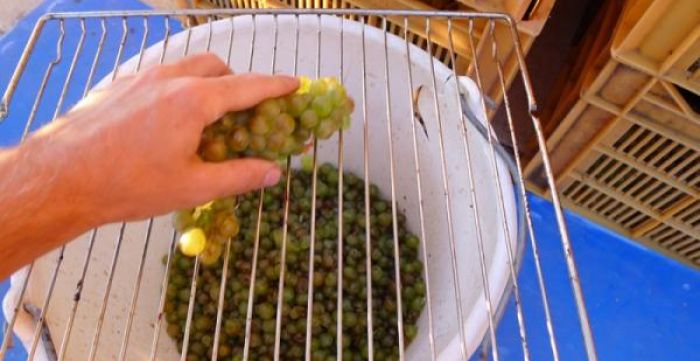
harvest report
16.04.2014
2014 Harvest Pictures from Eric Texier
<p><img src="http://louisdressner.com/uploads/images/article/2019_Sep_20//bc/a6/bca65c02925591d078f69a280f3e08fa.jpg" /></p>
<p><img src="http://louisdressner.com/uploads/images/article/2019_Sep_20//a3/b5/a3b57cd16412e1861d529516aafcc0d0.jpg" /></p>
<p><img src="http://louisdressner.com/uploads/images/article/2019_Sep_20//a5/7e/a57e9a88da9c74451c9804c3c59c4756.jpg" /></p>
<p><img src="http://louisdressner.com/uploads/images/article/2019_Sep_20//0a/54/0a5419bb660fc2be80f610cc6e33f043.jpg" /></p>
<p><img src="http://louisdressner.com/uploads/images/article/2019_Sep_20//72/73/7273f0f193af59281e77c837d2a97e79.jpg" /></p>
<p><img src="http://louisdressner.com/uploads/images/article/2019_Sep_20//f1/2d/f12dd041ed5167db6ead87d4bfafcd38.jpg" /></p>
<p><img src="http://louisdressner.com/uploads/images/article/2019_Sep_20//04/89/04890ba92ddf2bcc8b847a46eb6ead0b.jpg" /></p>
<p><img src="http://louisdressner.com/uploads/images/article/2019_Sep_20//e5/7e/e57ec25d8f506601f3e8d43d053610b5.jpg" /></p>
<p><img src="http://louisdressner.com/uploads/images/article/2019_Sep_20//2a/b7/2ab75af2e1f449327627f7d050343a59.jpg" /></p>
<p><img src="http://louisdressner.com/uploads/images/article/2019_Sep_20//6f/fe/6ffeafca576aa6519f4c1734624cf3fe.jpg" /></p>
<p><img src="http://louisdressner.com/uploads/images/article/2019_Sep_20//8f/c6/8fc6b6bd7474a50c10ea9f62a7291311.jpg" /></p>
<p><img src="http://louisdressner.com/uploads/images/article/2019_Sep_20//1b/5b/1b5b22e96cdb0712e9b61ba8f01f5bcd.jpg" /></p>
<p><img src="http://louisdressner.com/uploads/images/article/2019_Sep_20//ea/d6/ead66f198c4f72a1e9d50bacae3361da.jpg" /></p>
<p><img src="http://louisdressner.com/uploads/images/article/2019_Sep_20//9c/9b/9c9b2ac482f80daae7f5fb7ffc814daa.jpg" /></p>
<p><img src="http://louisdressner.com/uploads/images/article/2019_Sep_20//c7/dd/c7dde373d14524ba2b2d4d43e3863c7f.jpg" /></p>
Article
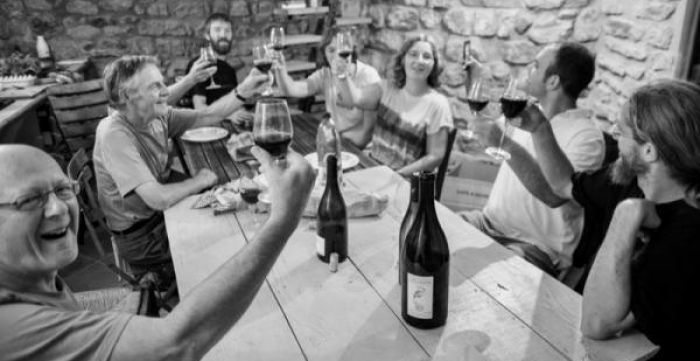
harvest report
11.10.2013
2013 Harvest Report from Eric Texier
<p>2013: the spring that never came, <glossary term="Frost" title="1135">frost</glossary> in late May, rain and cold during <glossary title="1179">flowering</glossary>; not a great start to the season! And then a very nice July that caught up about three weeks lost in spring. Followed by August, with its severe and very ususual attack of <span class="zalup"><span><glossary title="1137">mildew</glossary><span>,</span></span></span> stripping us of some of our whites in <glossary title="204">Brézème</glossary> and <span class="zalup"><span><glossary term="Saint-Julien-en-Saint-Alban" title="889">Saint-Julien en Saint-Alban</glossary><span>.</span></span></span></p>
<p>This is what we'd faced entering the month of September, still about 15 days late compared to last year. In the end, the Gods decided to be nice. Dry weather, fresh nights and radiant sunlight during the day permitted the grapes to ripen and stay healthy.<br />
<br />
The <glossary title="521">harvest</glossary> really started on September 23rd in <glossary term="Saint-Julien-en-Saint-Alban" title="889">Saint-Julien</glossary>'s old <glossary title="1001">Syrah</glossary> vines, as we waited for our <glossary title="1111">Viogniers</glossary> and <glossary title="276">Chasselas</glossary> to ripen. The <glossary title="204">Brézème</glossary> <glossary title="1001">Syrah</glossary> followed, still under the sun. The <glossary term="alcoholic potential" title="1381">alcoholic potential</glossary> is reasonable this year (nothing above 13°), and the <glossary title="71">acidities</glossary> are magnificent. Not a single rotten grape, to the point where the <glossary term="Sorting" title="1380">sorting</glossary> table ended up serving as a transportation mat! <glossary title="441">Fermentations</glossary> kicked off quickly and vigorously, and morale was high.<br />
<br />
Next up, we headed back to <glossary title="204">Brézème</glossary> for the <span class="zalup"><span><glossary title="878">Roussanne</glossary><span>,</span></span></span> which weren't looking that great. But we were pleasantly surprised at <span class="zalup"><span><glossary title="827">press</glossary><span>,</span></span></span> as the grapes were a lot riper than we'd orginally imagined. We then rushed over to the <glossary title="1111">Viognier</glossary> and <glossary title="276">Chasselas</glossary> in <glossary term="Saint-Julien-en-Saint-Alban" title="889">Saint-Julien</glossary> to check on their <span class="zalup"><span><glossary title="71">acidities</glossary><span>,</span></span></span> but it was too late! They had shot down drastically in just a few days, and this means we won't be producing any "Opale" or "Rouletabulle" this year. A good slap in the face and a serious reminder that we still have much to learn and understand.<br />
<br />
Somewhat panicked, we rushed in the remaining whites in <span class="zalup"><span><glossary term="Saint-Julien-en-Saint-Alban" title="889">Saint-Julien</glossary><span>.</span></span></span> The old <glossary title="634">Marsanne</glossary> from the Hospital <glossary title="760">parcel</glossary> were <glossary title="521">harvested</glossary> seperately, and there will be a<font color="#7b143e"><strong> "</strong></font>Domaine Pergaud Saint Julien" white for the first time in 2013. <glossary title="1129">Yields</glossary> for the whites are globally tiny because of <span class="zalup"><span><glossary title="1137">mildew</glossary><span>,</span></span></span> so there will not be much white in the "Chat Fou" 2013, and just barely half of last year's "Adèle" production.<br />
<br />
We then headed to the young <glossary title="1001">Syrahs</glossary> in <span class="zalup"><span><glossary term="Saint-Julien-en-Saint-Alban" title="889">Saint-Julien</glossary><span>,</span></span></span> where <glossary title="639">maturities</glossary> were similar to <span class="zalup"><span><glossary title="204">Brézème</glossary><span>.</span></span></span> It will be very interesting comparing the two in coming months.<br />
<br />
We kept the hardest for last with the <span class="zalup"><span><glossary title="508">Grenache</glossary><span>.</span></span></span> The damage due to <glossary term="Coulure" title="1252">coulure</glossary> was severe. A veteran <glossary title="1089">vigneron</glossary> from the <glossary term="Rhône Region" title="1209">Rhône</glossary> valley explained it to me years ago: <glossary title="508">Grenache</glossary> doesn't do two things at once. This year it was very vigorous around <span class="zalup"><span><glossary title="1179">flowering</glossary><span>,</span></span></span> which made it very susceptible to <span class="zalup"><span><glossary term="Coulure" title="1252">coulure</glossary><span>.</span></span></span> Its abnormal charge of fruit messed with its proper development over the rest of the season. In the end, it will be a low year for <span class="zalup"><span><glossary title="508">Grenache</glossary><span>,</span></span></span> who produced around 25<glossary title="528">hl/h</glossary> in <glossary term="Saint-Julien-en-Saint-Alban" title="889">Saint-Julien</glossary> and 20<glossary title="528">hl/h</glossary> in <glossary term="Vaison-la-Romaine" title="1062">Vaison la Romaine</glossary> and <span class="zalup"><span><glossary title="277">Châteauneuf du Pape</glossary><span>.</span></span></span> To add to the challenge, we were constantly checking the skins for ripening, endlessely hopping from one <glossary title="760">parcel</glossary> to another. <glossary title="639">Maturities</glossary> were very heterogeneous, forcing us to do multiple passes to wrap up the <span class="zalup"><span><glossary title="521">harvest</glossary><span>.</span></span></span><br />
<br />
After two long weeks, all of the grapes had been picked and our losses were limited to 10 to 15% compared to a normal year. That's nothing compared to a lot of friends in other regions who suffered tremendously this year.<br />
<br />
With these extremely ripe grapes, <glossary title="1104">vinifications</glossary> were off to a nice start, but a few uncooperative <glossary title="1140">vats</glossary> gave us the chills. All of the <glossary title="622">malolactic fermentations</glossary> were finished, but for two <span class="zalup"><span><glossary title="1140">vats</glossary><span>,</span></span></span> the risk of certain bacterias causing a deviation was strong. Spotting this risk a few days into the <span class="zalup"><span><glossary title="610">maceration</glossary><span>,</span></span></span> we quickly <glossary title="843">racked</glossary> these out to chill the juice, letting the <glossary title="1128">yeasts</glossary> finish their work without those pesky bacteria getting in the way. And lo and behold, the sugars finally finished without any spikes in <glossary term="Volatile Acidity" title="1116">volatility</glossary> and without the need to add <glossary title="993">SO2</glossary> or worst, <span class="zalup"><span><glossary term="lysozyme" title="1400">lysozymes</glossary><span>.</span></span></span></p>
<p><img src="http://louisdressner.com/uploads/images/article/2019_Sep_20//52/c0/52c0200934bc5da71172b0d498a68b61.jpg" /></p>
<p><img src="http://louisdressner.com/uploads/images/article/2019_Sep_20//1a/02/1a021472d7ca253b2d756223bcd71a6b.jpg" /></p>
<p><img src="http://louisdressner.com/uploads/images/article/2019_Sep_20//27/47/2747df6c3cd83c6515ed866f64881fde.jpg" /></p>
<p><img src="http://louisdressner.com/uploads/images/article/2019_Sep_20//60/b6/60b64a5bec3278ea0d47e0f607a314b3.jpg" /></p>
<p><img src="http://louisdressner.com/uploads/images/article/2019_Sep_20//2d/e6/2de6fbcc050ea0481c808bbc99bda6ce.jpg" /></p>
<p><img src="http://louisdressner.com/uploads/images/article/2019_Sep_20//11/4b/114b901022b0a203bd0caa9f70509b07.jpg" /></p>
<p><img src="http://louisdressner.com/uploads/images/article/2019_Sep_20//e0/59/e0599560fb528fefa5bff89c29e27951.jpg" /></p>
<p><img src="http://louisdressner.com/uploads/images/article/2019_Sep_20//ea/3b/ea3b7ea8e96b0f7d5443142f306d9a06.jpg" /></p>
<p><img src="http://louisdressner.com/uploads/images/article/2019_Sep_20//9e/46/9e46b5d174d7fef709e0385b1f266b62.jpg" /></p>
<p><img src="http://louisdressner.com/uploads/images/article/2019_Sep_20//c7/dc/c7dcc07c0901b2ee1937ac1a2c7cbf5c.jpg" /></p>
<p><img src="http://louisdressner.com/uploads/images/article/2019_Sep_20//d5/08/d508c23cc40026e971b4e5ee3af6ed83.jpg" /></p>
<p><img src="http://louisdressner.com/uploads/images/article/2019_Sep_20//40/c6/40c68c10a9566a50de6c464bc2a1fa45.jpg" /></p>
<p><img src="http://louisdressner.com/uploads/images/article/2019_Sep_20//17/de/17de899bf82a8b7caa544ca9e94f9d18.jpg" /></p>
<p><img src="http://louisdressner.com/uploads/images/article/2019_Sep_20//5e/eb/5eeb592a227122b6769a8343218dbfdd.jpg" /><img src="http://louisdressner.com/uploads/images/article/2019_Sep_20//6c/4b/6c4b31d816b26f7904200dc5a89f6ec1.jpg" /></p>
Article
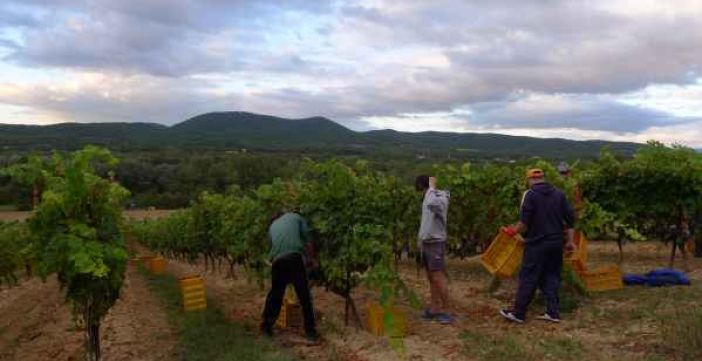
harvest report
11.09.2012
2012 Harvest Report from Eric Texier
<p>Finally, we're done with our "2" <span class="zalup"><span><glossary title="521">harvest</glossary><span>.</span></span></span>.. I've always heard <glossary title="1089">vignerons</glossary> from the South explain that <glossary title="1109">vintages</glossary> ending in "2" are always a total shit-show. I've experienced two of them (1992 and 2002), and they had both lived up to their reputation: impossible to <glossary title="521">harvest</glossary> at optimal <glossary title="639">maturity</glossary> because of torrential rains that caused memorable flooding... Everything was rotting at unprecedented rates!<br />
<br />
So we were expecting the worst with 2012, and this manifested itself with a ravaging <glossary title="1136">hail</glossary> storm in <glossary title="204">Brézème</glossary> on the 7th of July. In 5 minutes, a tornado of <glossary title="">hail</glossary> massacred half of the whites and a third of the reds. It was somehow not nearly as bad as it originally looked, and we have to thank the <glossary title="667">Mistral</glossary> for blowing this storm away over the next few days.<br />
<br />
Still, we attacked our <glossary title="521">harvest</glossary> with a positive attitude. Starting August 15th, a period of high heat helped heal and dry the grapes that had survived. The immediate result: the <glossary title="276">Chasselas</glossary> from <glossary term="Saint-Julien-en-Saint-Alban" title="889">Saint Julien</glossary> (destined for the "Rouletabulle") started <glossary title="639">maturing</glossary> very quickly and we had to <glossary title="521">harvest</glossary> them on August 24th, early in the morning to avoid the afternoon's scorching 38°.<br />
<br />
Next was the <glossary title="698">Muscat</glossary> on the 31st. After a first try that ended slightly <glossary title="694">moelleux</glossary> (25g of <glossary title="853">residual sugar</glossary>) that I <glossary term="Disgorgement" title="393">disgorged</glossary> last year, I'm going to attempt <glossary title="1104">vinifying</glossary> some of it <glossary term="Dry/Sec" title="405">dry</glossary> (and non <glossary term="Disgorgement" title="393">disgorged</glossary>) this year.<br />
<br />
My lab analysis on September 4th makes it clear we're going to have to kick things into high gear: <glossary title="71">acidities</glossary> are very low, the grapes taste ripe and the reds' juice is starting to take color. On September 10th, we start with <glossary term="Saint-Julien-en-Saint-Alban" title="889">Saint Julien</glossary>'s <span class="zalup"><span><glossary term="Serine" title="1325">Serines</glossary><span>.</span></span></span> Next up, the <span class="zalup"><span><glossary title="204">Brézème</glossary><span>:</span></span></span> first the white, then the red. The <glossary title="1136">hail</glossary> damage is serious: 30 to 50% of the grapes <glossary title="430">exposed</glossary> west are completely dried out, so a lot of first <glossary term="Pass" title="1144">pass</glossary> <glossary term="Sorting" title="1380">sorting</glossary> is necessary. We then tried eliminating a lot more grapes with a second <glossary term="Pass" title="1144">pass</glossary> on the <glossary term="Sorting" title="1380">sorting</glossary> table, but quickly realized that we weren't going to get these dried out grapes off without <span class="zalup"><span><glossary title="378">destemming</glossary><span>.</span></span></span><br />
<br />
So for the first time since 2003, the <glossary title="204">Brézèmes</glossary> are 100% <span class="zalup"><span><glossary title="378">destemmed</glossary><span>.</span></span></span> We kept the stems to eliminate the dry grapes (this is a lot easier once the good grapes have been removed) and reincorporated about 25% of them in the <span class="zalup"><span><glossary title="365">cuve</glossary><span>.</span></span></span> And because there was still a little bit of dry grapes left in there, I decided to cut the <glossary title="362">cuvaison</glossary> time as soon as the sugars had fully <glossary title="441">fermented</glossary> (between 12 and 16 days after they'd been tanked).<br />
<br />
Once we'd actually <glossary term="Pressing" title="827">pressed</glossary> and started <glossary title="1104">vinifying</glossary> the wines, we were able to have an idea of the actual <glossary title="1136">hail</glossary> damage: we lost 50% of the <glossary title="878">Roussanes</glossary> (but strangely none of the <glossary title="740">old vines</glossary>) and 20% of the <glossary title="1001">Syrah</glossary> compared to a normal <span class="zalup"><span><glossary title="1109">vintage</glossary><span>.</span></span></span> It's hard to complain when you know how much worst it was for some of our friends...<br />
<br />
After <span class="zalup"><span><glossary title="204">Brézème</glossary><span>,</span></span></span> we returned to <glossary term="Saint-Julien-en-Saint-Alban" title="889">Saint Julien</glossary> for the <glossary title="508">Grenaches</glossary> and the whites. It's a miracle! Nothing dried out, nothing rotten. The <glossary title="521">harvest</glossary> is copious and of good quality. <glossary title="71">Acidities</glossary> are a little moderate, but low alcohol and superb <span class="zalup"><span><glossary title="639">maturity</glossary><span>.</span></span></span> These will produce easy and ready to drink wines. I even considered making a <glossary title="725">primeur</glossary> for the first time in my life!<br />
<br />
The next Monday morning, all of <glossary title="204">Brézème</glossary> and <glossary term="Saint-Julien-en-Saint-Alban" title="889">Saint Julien</glossary> have been <glossary title="521">harvested</glossary> and in the <span class="zalup"><span><glossary title="1140">tanks</glossary><span>!</span></span></span> In the end, I am relieved to see how much we were actually able to <span class="zalup"><span><glossary term="Harvest" title="521">harvest</glossary><span>.</span></span></span><br />
<br />
On Friday, the 21st, we all set out to <span class="zalup"><span><glossary title="213">Bussières</glossary><span>.</span></span></span> The weather is beautiful, though a bit cold in the morning. Still, I love that fresh, morning ambiance, the colors of fall surrounding us while we <span class="zalup"><span><glossary title="521">harvest</glossary><span>.</span></span></span> It's such an incredible energy, and unfortunately, every year global warming is making our <glossary title="521">harvests</glossary> more and more precocious, stripping me of these moments. The grapes are fantastic and the juice is excellently balanced.<br />
<br />
Taking a break in <span class="zalup"><span><glossary title="273">Charnay</glossary><span>,</span></span></span> we got to see our <glossary title="151">Beaujolais</glossary> buddies <glossary title="521">harvesting</glossary> the little bit of grapes 2012 decided to leave them. But even though the juice is rare, it's beautiful!<br />
<br />
Wednesday the 26th: <span class="zalup"><span><glossary title="277">Châteauneuf</glossary><span>.</span></span></span> It's hot out! The <glossary title="297">Clairettes</glossary> and <glossary term="Bourboulenc" title="1253">Bourboulenc</glossary> are in good shape, and we <glossary title="521">harvested</glossary> them a whole 15 days later than last year. Unlike <span class="zalup"><span><glossary title="204">Brézème</glossary><span>,</span></span></span> the time lapse between <glossary title="1179">flowering</glossary> and <glossary title="521">harvest</glossary> is normal here. The following Monday, we <glossary title="521">harvested</glossary> the reds (a lot of <glossary term="Sorting" title="1380">sorting</glossary> since <glossary title="639">maturities</glossary> varied greatly), then we were off to <glossary term="Saint-Joseph" title="888">Saint-Joseph</glossary> and <span class="zalup"><span><glossary title="373">Côte-Rotie</glossary><span>.</span></span></span> Over there, no illness or <span class="zalup"><span><glossary title="1136">hail</glossary><span>:</span></span></span> a lot of clean, ripe grapes with low <glossary title="71">acidity</glossary> and low alcohol.<br />
<br />
This year really reminds me of 2000, minus the low <glossary title="1129">yields</glossary> because of <span class="zalup"><span><glossary title="1136">hail</glossary><span>.</span></span></span> It was also a <glossary title="1109">vintage</glossary> where I learned a lot about <span class="zalup"><span><glossary title="1137">mildew</glossary><span>,</span></span></span> and I have many swiss <glossary title="1089">vignerons</glossary> to thank for sharing their experiences using herbal cures such as bourdaine.<br />
<br />
I was surprised and touched by the solidarity of my fellow <glossary title="1089">vignerons</glossary> dealing with the elements in 2012. It makes me remember the wise advice Christian Chaussard gave me about <glossary term="Oidium" title="737">black rot</glossary> over a beer in Stockholm last May. Thank you Chocho for your bright, pertinent rationalities in this complex world of <glossary title="1103">viticulture</glossary> and naturally made wine.</p>
<p><img src="http://louisdressner.com/uploads/images/article/2019_Sep_23//8d/4d/8d4d535dd3755a8ebed8233fddf0fc78.jpg" /></p>
<p><img src="http://louisdressner.com/uploads/images/article/2019_Sep_23//23/db/23dbd87b0dab065efdc82bcb9525573d.jpg" /></p>
<p><img src="http://louisdressner.com/uploads/images/article/2019_Sep_23//95/ca/95ca9623bdef358de3358917adef6c36.jpg" /></p>
<p><img src="http://louisdressner.com/uploads/images/article/2019_Sep_23//e0/7e/e07e8bfc0a09f611371c2e7a7d49eec0.jpg" /></p>
<p><img src="http://louisdressner.com/uploads/images/article/2019_Sep_23//c6/1f/c61f1abf593eaf2521f0aed7946aad32.jpg" /></p>
<p><img src="http://louisdressner.com/uploads/images/article/2019_Sep_23//b1/39/b1396b0f4872dee7178b0713fb3028e0.jpg" /></p>
<p><img src="http://louisdressner.com/uploads/images/article/2019_Sep_23//cc/a8/cca863011fbbb522630d4f2546f29a71.jpg" /></p>
<p><img src="http://louisdressner.com/uploads/images/article/2019_Sep_23//ce/42/ce42dba01da8a9ec3490ecd52cdd2935.jpg" /></p>
<p><img src="http://louisdressner.com/uploads/images/article/2019_Sep_23//e4/03/e4031ab99c68ee28193055c5186812c1.jpg" /></p>
<p><img src="http://louisdressner.com/uploads/images/article/2019_Sep_23//02/d3/02d3a4700dde58f636a83fd03b784929.jpg" /></p>
<p><img src="http://louisdressner.com/uploads/images/article/2019_Sep_23//a2/95/a2954feb72785bf223d28fcaf251e31c.jpg" /></p>
Article
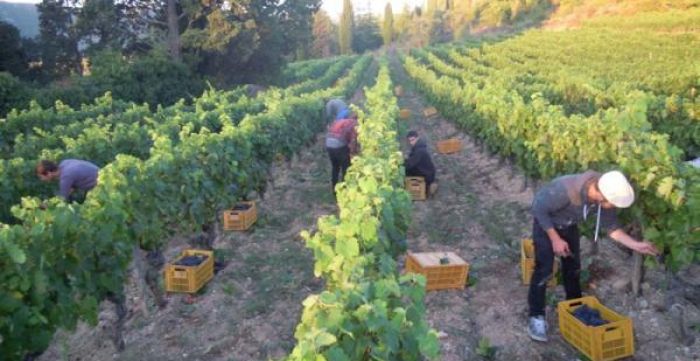
harvest report
09.10.2011
2011 Harvest Report from Eric Texier
<p>It came and went; another <span class="zalup"><span><glossary title="521">harvest</glossary><span>.</span></span></span> The fastest in our history! All the wines were finished and cleared on September 30th! We've never seen anything like this, not even in 2003.<br />
<br />
We started <glossary title="521">harvesting</glossary> <glossary title="276">Chasselas</glossary> in <glossary title="889">Saint Julien</glossary> (for a new <glossary title="778">pétillant natural</glossary>) on August 16th, and we finished with the <glossary title="508">Grenache</glossary> in <glossary title="1062">Vaison</glossary> on September 9th.<br />
<br />
Abundant <span class="zalup"><span><glossary title="1129">yields</glossary><span>,</span></span></span> grapes of high quality (with striking <glossary title="71">acidity</glossary>), a <glossary title="521">harvest</glossary> team composed of my sons Martin and Léo and a group of their friends, beautiful weather, sunny but cool: in other words an ideal and very pleasant <span class="zalup"><span><glossary title="521">harvest</glossary><span>.</span></span></span><br />
<br />
In the <glossary title="254">cellar</glossary> we had some very fast and tumultuous <glossary title="441">fermentations</glossary> (five days for the <glossary title="740">old vine</glossary> <glossary title="1325">Serines</glossary> of <glossary title="204">Brézème</glossary> to be sugarless!!!) A lot of <glossary title="142">barrels</glossary> overflowing and temperatures skyrocketing caused some initial worry but in the end were of no consequence to the very pure fruit of this <span class="zalup"><span><glossary title="521">harvest</glossary><span>.</span></span></span> It reminds me of 2000 and 2006.<br />
<br />
We <glossary title="521">harvested</glossary> a lot of young vines this year: five <glossary title="523">hectares</glossary> of <span class="zalup"><span><glossary title="508">Grenache</glossary><span>,</span></span></span> <span class="zalup"><span><glossary title="1188">Cinsault</glossary><span>,</span></span></span> <glossary title="297">Clairette</glossary> and <glossary title="634">Marsanne</glossary> in <span class="zalup"><span><glossary title="889">Saint Julien</glossary><span>,</span></span></span> and as of this <glossary title="1109">vintage</glossary> our generic <glossary title="372">Cotes-du-Rhône</glossary> red and white will come entirely from <span class="zalup"><span><glossary title="889">Saint Julien en St Alban</glossary><span>.</span></span></span><br />
<br />
We also <glossary title="521">harvested</glossary> some <glossary title="698">Muscat</glossary> and <glossary title="276">Chasselas</glossary> in hopes of making a <span class="zalup"><span><glossary title="778">pétillant natural</glossary><span>!</span></span></span> It's proving to be a lot of fun and is new territory for the whole team….<br />
<br />
We started picking for the "Opale" on August 29th in suffocating heat. We <glossary title="521">harvested</glossary> an additional <glossary title="523">hectare</glossary> of some <glossary title="1130">young vines</glossary> for the first time this year and in such doubled our production of this wine.<br />
<br />
Globally, balance dominates the wines we've obtained this year. Less dense than 2009, but sunnier than 2010, the reds from the Northern <glossary title="1209">Rhône</glossary> are between 12 and 12.5% with the exception of <glossary title="1062">Vaison</glossary> at 13.5% (it took a bit longer to mature than usual this year).<br />
<br />
The whites have striking <glossary title="71">acidity</glossary> and it is quite probable that <glossary title="622">malo</glossary> will occur for all the wines.<br />
<br />
Unlike the Southern <glossary title="1209">Rhône</glossary> where rot was quickly spreading in late August, the <glossary title="521">harvest</glossary> in <glossary title="204">Brézème</glossary> and <glossary title="889">Saint Julien</glossary> were very healthy and did not require a pass on the tray table like last year.<br />
<br />
All of the wines were <glossary title="1104">vinified</glossary> without any <glossary title="993">SO2</glossary> during the <span class="zalup"><span><glossary title="521">harvest</glossary><span>,</span></span></span> or at all for the majority of the reds.<br />
<br />
There you go. Now we're on vacation so we can go bother our friends who aren't done <glossary title="521">harvesting</glossary> yet!</p>
<p><img src="http://louisdressner.com/uploads/images/article/2019_Sep_25//a6/c3/a6c399120663f005db00b7039bdfefb6.jpg" /></p>
<p><img src="http://louisdressner.com/uploads/images/article/2019_Sep_25//44/e6/44e694816c203c541035e9936c091494.jpg" /></p>
Article
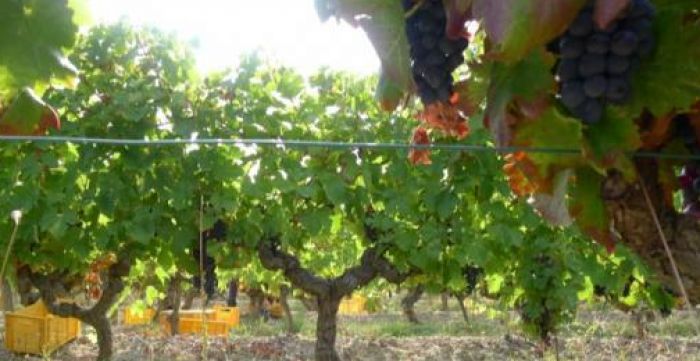
harvest report
10.10.2010
2010 Harvest Report from Eric Texier
<p>On Tuesday, August 31st, we’ll pick our first grapes of <glossary title="1109">vintage</glossary> 2010, <glossary title="1111">Viognier</glossary> for "Opale". For this particular wine, all conditions are right for a great crop, in quantity and quality, with 11.5 of <glossary title="1381">potential alcohol</glossary> and 5.5g/l of <span class="zalup"><span><glossary title="71">acidity</glossary><span>,</span></span></span> this is a true <glossary title="1111">Viognier</glossary> from the <span class="zalup"><span><glossary title="689">Mosel</glossary><span>!</span></span></span><br />
<br />
The summer season has given us various frights: a stretch of super hot weather in early July was followed by severe rain storms with <glossary title="1136">hail</glossary> threats, a cold spell in early August left us with <glossary title="737">oïdium</glossary> on the <glossary title="878">Roussanne</glossary> in <glossary title="204">Brézème</glossary> and a small crop for this wine. For all other grapes, we are very optimistic, but it will take another five to six weeks before everything is in.</p>
Article
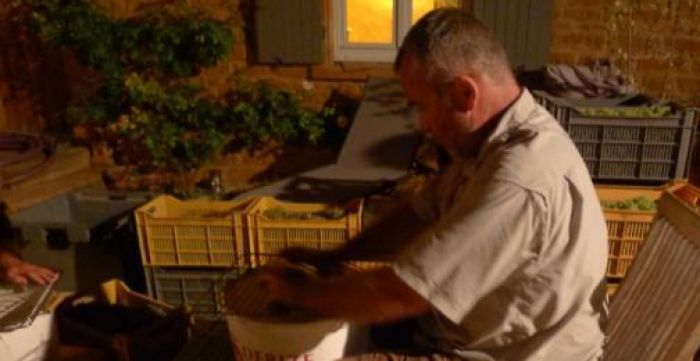
harvest report
06.10.2009
2009 Harvest Report from Eric Texier
<p>The easiest year I've ever seen...<br />
<br />
I've been able to <glossary title="521">harvest</glossary> every <glossary title="1133">plot</glossary> at its exact perfect ripeness (according to my understanding of perfect ripeness of course).<br />
<br />
I tried many things I wanted to try for years, like a <glossary term="Recioto" title="846">recioto</glossary> of <glossary term="Syrah" title="1001">Syrah</glossary> from <span class="zalup"><span><glossary title="204">Brézème</glossary><span>.</span></span></span> Everybody should be pleased. You could <glossary title="521">harvest</glossary> early with bright <glossary title="71">acidities</glossary> and very good <glossary title="784">phenolic</glossary> ripeness or <glossary title="521">harvest</glossary> late and get huge <span class="zalup"><span><glossary title="324">concentration</glossary><span>,</span></span></span> alcohol levels and dark as hell wines.<br />
<br />
Amazing really.<br />
<br />
Again, all styles were possible in a natural way. As if nature was tired of <span class="zalup"><span><glossary term="Reverse Osmosis" title="1401">reverse osmosis</glossary><span>,</span></span></span> over <glossary title="70">acidification</glossary> or <glossary term="Irrigation" title="549">irrigation</glossary> :)<br />
<br />
High <glossary title="1129">yields</glossary> (not huge though) in the northern <span class="zalup"><span><glossary term="Rhône Region" title="1209">Rhône</glossary><span>,</span></span></span> which will please the lovers of balance wines (very opposite to 2005 wines). Low <glossary title="1129">yields</glossary> in the southern <glossary term="Rhône Region" title="1209">Rhône</glossary> but with slow <span class="zalup"><span><glossary title="639">maturation</glossary><span>.</span></span></span> People who achieved a 2007 style (which I really don't like at all in <span class="zalup"><span><glossary title="277">Châteauneuf</glossary><span>,</span></span></span> including my red which I'm still trying to bring back to something less <span class="zalup"><span><glossary term="Porto" title="744">port</glossary><span>-</span></span></span>like and more drinkable by working with <span class="zalup"><span><glossary title="590">lees</glossary><span>.</span></span></span>..) will have chosen it.<br />
<br />
BTW, I have lost my Saint Gervais source. Due to the crisis it will be transformed into a swimming pool or a jardin à la française by some rich English people during this winter... how sad.</p>
Article
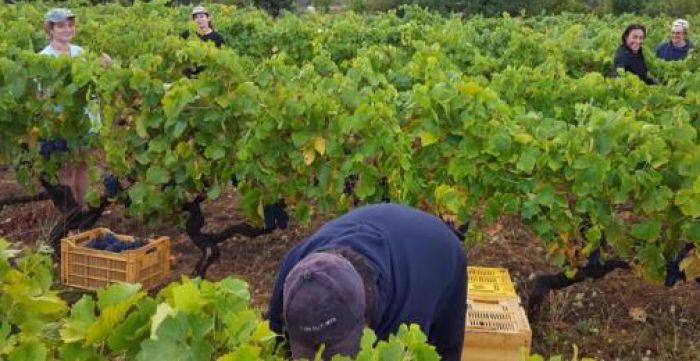
harvest report
03.10.2008
2008 Harvest Report from Eric Texier
<p>On Thursday Sept. 11th (what a coincidence) I was driving north from <span class="zalup"><span><glossary title="277">Châteauneuf</glossary><span>,</span></span></span> where the whites were almost ready to be picked. That would happen the following Monday and Tuesday (15th and 16th). The weather was beautiful, at long last, after a rotten summer, and, contrary to 2007, a bad start to September. Depressing….<br />
<br />
Near the city of Donzère, where the <glossary title="831">provençal</glossary> vegetation disappears and the Northern <glossary title="1209">Rhône</glossary> starts, the sky darkened to a black ink color, and five minutes later, I had to stop on the side of the highway. It was raining so hard that I couldn’t see a thing outside. In two hours, between 100 and 150mm of rain fell between Montélimar and Lyon.<br />
<br />
Now I’m not depressed, I’m desperate! From <glossary title="373">Côte Rôtie</glossary> to <span class="zalup"><span><glossary title="204">Brézème</glossary><span>,</span></span></span> our unripe <glossary title="1001">Syrah</glossary> and already fragile whites are going to bite the dust, for sure.<br />
<br />
<br />
Next year I’m going to start making beer…<br />
<br />
And then, the <span class="zalup"><span><glossary title="667">Mistral</glossary><span>,</span></span></span> blowing for 10 whole days.<br />
<br />
There is no real ripening, but <glossary title="182">gray rot</glossary> has been stopped, and the <glossary title="181">noble rot</glossary> on the whites is concentrating. So, we are waiting. And we are waiting a bit longer, since it’s not raining. We’ll pick in the south at the end of next week.<br />
<br />
Thursday, September 18th: 120mm of rain! Just as we were going to start. Oh, the <glossary title="667">Mistral</glossary> is back, that’s a good thing.<br />
<br />
On October 3rd, here’s where we are:<br />
<br />
-The whites have all been picked<br />
<br />
-A good year in <span class="zalup"><span><glossary title="277">Châteauneuf</glossary><span>,</span></span></span> similar to 2005 with lively <glossary title="71">acidity</glossary><br />
<br />
-"Opale", just like last year, with 15-10% <glossary title="181">noble rot</glossary><br />
<br />
<span class="zalup"><span><span>-</span><glossary title="326">Condrieu</glossary> </span></span>with even more <span class="zalup"><span><glossary title="181">botrytis</glossary><span>,</span></span></span> and incredibly high <glossary title="71">acidity</glossary> (8 to 10 g of <glossary title="1012">tartaric acid</glossary>)<br />
<br />
<span class="zalup"><span><glossary title="204">Brézème</glossary><span>:</span></span></span> extra-terrestrial! More than half the crop in deep purple <span class="zalup"><span> <glossary title="181">botrytis</glossary><span>,</span></span></span> between 13 and 19 degrees of <span class="zalup"><span><glossary title="1381">potential alcohol</glossary><span>,</span></span></span> according to the <span class="zalup"><span><glossary title="1133">plots</glossary><span>,</span></span></span> 12 g of <glossary title="71">acidity</glossary> on the last picked. I have no idea what style we are going to achieve, but the <glossary title="700">must</glossary> has great <glossary title="120">aromatic</glossary> purity.<br />
<br />
In red, <glossary title="204">Brézème</glossary> will resemble 2006. It is a small crop, and we rejected about 20% of the grapes in the vines and on the <glossary title="1380">sorting</glossary> table. Thanks to all our pickers who did such careful sorting and understood that they were going to determine the quality of the <span class="zalup"><span><glossary title="1109">vintage</glossary><span>,</span></span></span> much more than I, the winemaker, would.<br />
<br />
70<glossary title="524">HL</glossary> of red wine are picked, out of 35 <span class="zalup"><span>0<glossary title="524">HL</glossary><span>.</span></span></span> Well, 350<glossary title="524">HL</glossary> in principle, we’ll surely end up with a lot less, because every passing day the crop diminishes.<br />
<br />
The weather is sunny and cold, the <glossary title="667">Mistral</glossary> is blowing, so we are waiting. For a miracle? For inspiration? I am not sure myself. It is as if we were all stiff and sleepy after this summer that never came and this cold and dry autumn. A <glossary title="521">harvest</glossary> borne by the winds, which stretches on and on without giving a hint of its true self.</p>
Article
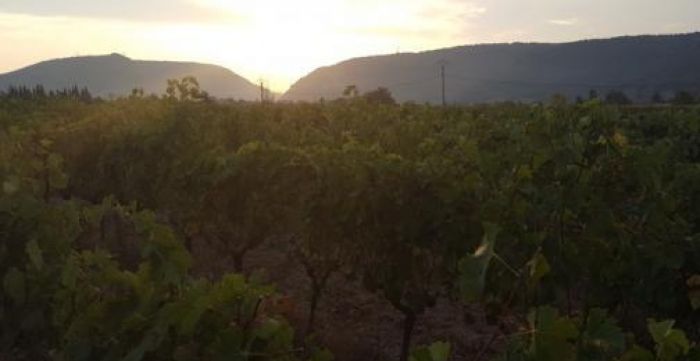
harvest report
24.09.2007
2007 Harvest Report from Eric Texier
<p>We’re done in <span class="zalup"><span> <glossary title="204">Brézème</glossary><span>.</span></span></span><br />
<br />
We will finish this week with the <glossary title="692">Mouvèdres</glossary> in <span class="zalup"><span> <glossary title="277">Châteauneuf</glossary><span>.</span></span></span><br />
<br />
The only rainy day since August 29, was last Monday and the <glossary title="667">Mistral</glossary> has been blowing practically every day.<br />
<br />
In <span class="zalup"><span> <glossary title="204">Brézème</glossary><span>,</span></span></span> in just one week (Sept 10-17), the <glossary title="1138">bunches</glossary> lost 15% of their weight and gained 25 g/l of sugar (more than 1.5 degrees of <glossary title="1381">potential alcohol</glossary>).<br />
<br />
The wind completely evaporated the excess of water that came our way in August!!!<br />
<br />
The <glossary title="1129">yields</glossary> are normal and the <glossary title="784">phenolic</glossary> ripeness and balance are both perfect.<br />
<br />
The stems were ripe, so the Pergault is 100% non <span class="zalup"><span><span>-</span><glossary title="378">destemmed</glossary>.</span></span><br />
<br />
But the nights are cool and the <glossary title="71">acidity</glossary> levels of the white grapes from <glossary title="277">Châteauneuf</glossary> to <glossary title="326">Condrieu</glossary> are exceptional.<br />
<br />
Obviously, this is perfect for the "Opale" : twice the <glossary title="1129">yield</glossary> as last year with perfect <glossary title="71">acidity</glossary> levels and ripeness.<br />
<br />
The situation is more difficult in the <glossary title="373">Côte Rôtie</glossary> where <glossary title="1136">hail</glossary> at the end of May left its mark.<br />
<br />
We can thank the <glossary title="667">Mistral</glossary> which single-handedly and completely reversed what looked like a less than wonderful situation in August. Pure Magic.<br />
<br />
We will start <glossary title="1140">de-vatting</glossary> on Thursday and the sugar in the whites is almost finished.</p>
Article

article
12.05.2007
2007 Harvest Report from Eric Texier
<p>As usual, the end of winter is for us a time to <glossary title="185">bottle</glossary> our wines.<br />
<br />
We had exceptional weather in April and <glossary title="185">bottled</glossary> in ideal conditions. We picked the best days to <glossary title="843">rack</glossary> perfectly <glossary title="299">clarified</glossary> and “happy” wines as we had constant high pressures and a North wind for three weeks.</p>
<p><glossary title="277">Châteauneuf-du-Pape</glossary> Rouge 2005:</p>
<p>2005 is a solar <span class="zalup"><span><glossary title="1109">vintage</glossary><span>,</span></span></span> and <glossary title="277">Châteauneuf-du-Pape</glossary> a solar <span class="zalup"><span><glossary title="1026">terroir</glossary><span>.</span></span></span> The <glossary title="692">Mourvèdre</glossary> grapes (two <glossary title="142">barrels</glossary>), which usually strain to reach optimum ripeness, have in this <glossary title="1109">vintage</glossary> an essential play into the final balance of the wine: the result is more fruit than spice, and quite close to 2001 in structure. Eight <glossary title="142">barrels</glossary> or 2240 bottles.<br />
<br />
There are two <glossary title="142">barrels</glossary> of old <glossary title="508">Grenache</glossary> from la Crau left, to be <glossary title="185">bottled</glossary> next fall or later under the label Improbable.</p>
<p><glossary title="204">Brézème</glossary> 2005:</p>
<p>Global warming is a positive factor in <span class="zalup"><span><glossary title="204">Brézème</glossary><span>!</span></span></span> For the third year in a row, we enjoyed a perfect growing season, which ended in late September with really ripe <glossary title="1001">Syrah</glossary> at 12% natural <span class="zalup"><span><glossary title="1381">potential alcohol</glossary><span>.</span></span></span> Denser than the 2004 <span class="zalup"><span><glossary title="1109">vintage</glossary><span>,</span></span></span> the wine is closer to a <glossary title="691">Moulin-à-Vent</glossary> than to a still <glossary title="744">Porto</glossary>… 9880 bottles</p>
<p><br />
The six <glossary title="142">barrels</glossary> of our oldest “Petites <glossary title="1325">Serines</glossary>” will be <glossary title="185">bottled</glossary> in June under the<strong> </strong>Domaine de Pergault label (around 1500 bottles and 150 <glossary title="617">magnums</glossary>)<br />
<br />
<glossary title="373">Côte Rôtie</glossary> 2005:</p>
<p>The biggest challenge in <glossary title="373">Côte Rôtie</glossary> was to avoid over ripeness and over<span class="zalup"><span><span>-</span><glossary title="324">concentration</glossary> </span></span>of the grapes, just like in <span class="zalup"><span><glossary title="326">Condrieu</glossary><span>,</span></span></span> given the weather conditions in 2005. The <glossary title="655">mica-schist</glossary> soils of Vernay and the old age of our “<glossary title="1325">Serines</glossary>” made it possible, at least in part. The wine is in the same style as 1999, and we think will be pleasurable early on and not meant for long <span class="zalup"><span><glossary title="74">aging</glossary><span>.</span></span></span> Three <glossary title="142">barrels</glossary> and a half, or 1002 bottles and 12 <span class="zalup"><span><glossary title="617">magnums</glossary><span>.</span></span></span><br />
<br />
Mâcon Bussières Très Vieilles Vignes 2005:</p>
<p>After a second winter spent in two and three year-old <span class="zalup"><span><glossary title="142">barrels</glossary><span>,</span></span></span> we <glossary title="185">bottled</glossary> this without <glossary title="449">fining</glossary> or <span class="zalup"><span><glossary title="447">filtering</glossary><span>.</span></span></span> This wine has great purity, although it is still marked by its <glossary title="1126">wood</glossary> <span class="zalup"><span><glossary title="74">aging</glossary><span>.</span></span></span> Its balance and <glossary title="662">minerality</glossary> should ensure great <glossary title="74">aging</glossary> potential. Eight <glossary title="142">barrels</glossary> gave a total of 2144 bottles and 36 <span class="zalup"><span><glossary title="617">magnums</glossary><span>.</span></span></span></p>
<p><glossary title="204">Brézème</glossary> <glossary title="878">Roussanne</glossary> 2006:</p>
<p>A novelty this year: in 2003, we planted 22 ares (0.22<glossary title="523">HA</glossary>) with <glossary title="941">sélection massale</glossary> of the old so-called “Roussettes” owned by François Pouchoulin; in 2006, these gave their first crop, tiny but eagerly expected. We <glossary title="168">blended</glossary> <glossary title="1130">young</glossary> and <span class="zalup"><span><glossary title="740">old vines</glossary><span>,</span></span></span> half and half, and reached the record crop of five <span class="zalup"><span><glossary title="142">barrels</glossary><span>,</span></span></span> or 1380 bottles. The wine is lighter, less dense than in previous <span class="zalup"><span><glossary title="1109">vintages</glossary><span>,</span></span></span> reminiscent of the year 2000.<br />
<br />
The last two, and best, <glossary title="142">barrels</glossary> of <strong><glossary title="740">old vines</glossary></strong> will be <glossary title="185">bottled</glossary> later and labeled under Domaine de Pergault (make your reservation asap.)</p>
<p><glossary title="277">Châteauneuf-du-Pape</glossary> <glossary title="163">blanc</glossary> <glossary title="740">Vieilles Vignes</glossary> 2005:</p>
<p>Like the <span class="zalup"><span><glossary title="213">Bussières</glossary><span>,</span></span></span> this is a very <span class="zalup"><span><glossary title="662">mineral</glossary><span>,</span></span></span> tightly wound wine. Only <glossary title="297">Clairette</glossary> and <glossary title="1253">Bourboulenc</glossary> went into the <glossary title="168">blend</glossary> this year, as last year. This has tremendous <glossary title="74">aging</glossary> potential, with the <glossary title="297">Clairette</glossary> fruit dominating right now, but the amazing <glossary title="1253">Bourboulenc</glossary> juice of 2005 will show its pedigree in some time. Similar to 2000, with even more style. Four <glossary title="142">barrels</glossary> or 1160 bottles.</p>
<p><glossary title="326">Condrieu</glossary> Janrode 2006:</p>
<p>It is the only <glossary title="326">Condrieu</glossary> we will bottle this <span class="zalup"><span><glossary title="1109">vintage</glossary><span>.</span></span></span> This extraordinary <glossary title="1133">plot</glossary> produced a lively and balanced wine, where the <glossary title="1071">varietal</glossary> character of <glossary title="1111">Viognier</glossary> disappears in favor of the <glossary title="662">minerality</glossary> of the soil. We judged the rest of the <glossary title="1111">Viognier</glossary> crop, from Vernon, to be characterless and too close to the majority of modern <glossary title="326">Condrieu</glossary> wines, and sold it in bulk. Two <glossary title="142">barrels</glossary> of new <glossary title="68">acacia</glossary> <glossary title="1126">wood</glossary> or 568 bottles.<br />
</p>
<p>Other News in <glossary title="273">Charnay:</glossary></p>
<p>Last summer, Eric showed us his newly rented <glossary title="254">cellar</glossary> in the village of <span class="zalup"><span><glossary title="273">Charnay-en-Beaujolais</glossary><span>,</span></span></span> where he lives. Close by, he pointed at a one <span class="zalup"><span><glossary title="523">hectare</glossary> </span></span>vineyard of <glossary title="478">Gamay</glossary> which he had acquired with a group of friends/investors and that he is tending it in <span class="zalup"><span><glossary title="160">biodynamie</glossary><span>.</span></span></span><br />
<br />
Eric had formed a non-profit association to maintain this site and to prevent it from becoming available to real estate developers. <glossary title="273">Charnay</glossary> is near Lyon and increasingly the vineyards are being ripped out to make way for new housing.<br />
<br />
The site is currently in the <glossary title="108">AOC</glossary> <glossary title="">Beaujolais</glossary> but the association decided to <glossary title="383">declassify</glossary> to <glossary title="1006">table wine</glossary> and to <glossary title="500">overgraft</glossary> with other grape varieties. This way, they would not compete with the <glossary title="151">Beaujolais</glossary> producers in the village.<br />
<br />
The goal is to produce delicious <span class="zalup"><span><glossary title="708">natural wine</glossary><span>,</span></span></span> available at a reasonable price to young people (of drinking age, of course) and residents of <glossary title="273">Charnay</glossary> who can’t afford good wine. Eric worries that too many young people are drinking plonk, going right to hard alcohol or beer and that the wine culture is losing out. The wine from this <glossary title="1133">plot</glossary> will eventually be sold in plastic jugs and will hopefully bring a new generation to the joys of wine. It will not be available on the American gray market.<br />
<br />
<glossary title="500">Overgrafting</glossary> is an interesting technique. Eric writes:<br />
<br />
“During the last week of April, we <glossary title="500">grafted</glossary> over an entire <span class="zalup"><span><glossary title="523">hectare</glossary><span>.</span></span></span> The summery weather and a powerful waxing moon made the sap surge in a spectacular fashion, very beneficial to the new <span class="zalup"><span><glossary title="500">grafts</glossary><span>.</span></span></span>”<br />
<br />
<glossary title="500">Overgrafting</glossary> is a technique that can jumpstart a new vineyard by replacing one <glossary title="1071">varietal</glossary> with another: the live vine (dormant since this is done at the very end of winter) is cut below the <glossary title="500">grafting</glossary> point, leaving only the <glossary title="869">rootstock</glossary> in place. A piece of cutting is <span class="zalup"><span><glossary title="500">grafted</glossary><span>,</span></span></span> i.e. inserted into or ligatured against, the wood of the <span class="zalup"><span><glossary title="869">rootstock</glossary><span>.</span></span></span><br />
<br />
Eric collected cuttings from his colleagues, <glossary title="216">Cabernet Franc</glossary> from Elian Da Ros in the Côtes du Marmandais (South West France), <glossary title="366">Malbec</glossary> from Matthieu Cosse in <span class="zalup"><span><glossary title="219">Cahors</glossary><span>,</span></span></span> and <glossary title="698">Muscat</glossary> from Jean Riché in Beaumes de Venise.<br />
<br />
Of course, Eric had a special joker to play this game. One of the last experienced grafters in France is Denis Clavel, from St-Gervais in the <span class="zalup"><span><glossary title="372">Côtes-du-Rhône</glossary><span>,</span></span></span> where for years Eric has been buying grapes for his St-Gervais Village and <glossary title="740">Old Vines</glossary> Cadinnières <span class="zalup"><span><glossary title="363">cuvée</glossary><span>.</span></span></span> Given the high cost of replanting vineyards with plants from a nursery, the Clavel family has perpetuated the now largely lost art of <glossary title="500">grafting</glossary> from <glossary title="941">sélection massale</glossary> in their own vineyards. Denis prepares the cuttings with an old tool, a relic of the past that cannot be bought anywhere.</p>
<p>A stick of wood is slipped into a slit directly into the <span class="zalup"><span><glossary title="869">rootstock</glossary><span>.</span></span></span><br />
<br />
Presto, no more <span class="zalup"><span><glossary title="478">Gamay</glossary><span>,</span></span></span> but baby vines of <span class="zalup"><span><glossary title="217">Cabernet</glossary><span>,</span></span></span> <glossary title="366">Malbec</glossary> or <glossary title="698">Muscat</glossary> with an old, strong root system, which will not suffer from <glossary title="1167">drought</glossary> nor excessive rain in their first years.<br />
<br />
The first <glossary title="521">harvest</glossary> is scheduled for the fall of 2010.</p>
Article
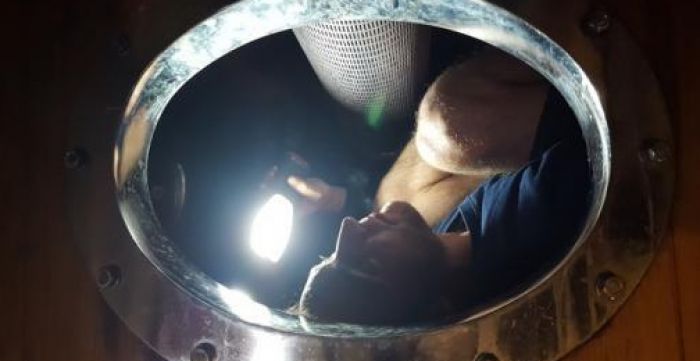
harvest report
10.10.2006
2006 Harvest Report from Eric Texier
<p>It wasn’t a great start: after a completely rotten month of August, the sun finally made an appearance arm in arm with the <glossary title="667">Mistral</glossary> and we were off to the races. The best <glossary term="Exposition" title="430">exposed</glossary> areas from Vernon to <glossary title="326">Condrieu</glossary> (where I get grapes for "Opale") ripened much too fast. On September 7th, more than 14% degrees of potential alcohol and less than 3 grams of <span class="zalup"><span><glossary title="71">acidity</glossary><span>,</span></span></span> it was a complete failure. Luckily, the lower part of the <glossary title="1133">plot</glossary> is perfect but the <glossary title="1129">yields</glossary> will be half of what we got in 2005.<br />
<br />
Next we harvested the white <glossary title="277">Châteauneuf</glossary> and <glossary title="372">Côtes du Rhône</glossary> grapes on September 12th and 13th. The <glossary title="508">Grenache</glossary> were already too ripe. So, for 2006, it will be <glossary title="297">Clairette</glossary> and <span class="zalup"><span><glossary term="Bourboulenc" title="1253">Bourboulenc</glossary><span>.</span></span></span> The <glossary title="538">natural yeasts</glossary> seem to be very hardy this year, the <glossary title="87">alcoholic fermentation</glossary> has been vigorous and rapid. One morning when Fabien (our “computer consultant turning chef/chi kung master” intern) went to the <glossary title="254">cellar</glossary> to check on the progress of the <span class="zalup"><span><glossary title="441">fermentation</glossary><span>,</span></span></span> he found all the vats happily bubbling over: at least half a <glossary title="142">barrel</glossary> sacrificed to the genies of my <span class="zalup"><span><glossary title="254">cellar</glossary><span>.</span></span></span><br />
<br />
A little cause for concern: as I have been checking the ripeness of the red <glossary title="">Grenache</glossary> grapes, I am finding some that are already at 14 degrees of <glossary term="alcoholic potential" title="1381">potential alcohol</glossary> with their skin still completely pink. Is this the result of global warming? At any rate, it is becoming hard for the grapes to obtain full ripeness in terms of their skin while remaining at reasonable sugar levels. Maybe we will end up having to plant <glossary title="508">Grenache</glossary> in <glossary title="373">Côte Rôtie</glossary> before too long. <glossary title="1001">Syrah</glossary> will move up to <glossary title="212">Burgundy</glossary> and <glossary title="805">Pinot Noir</glossary> to Scotland.<br />
<br />
Next, we harvested both the white and red <glossary title="204">Brézème</glossary> on September 17th, 18th and 19th. It has been an abundant year (94<glossary term="Hectoliter" title="524">hl</glossary> / 2.2 <glossary title="523">ha</glossary>) and it’s all extremely healthy. This is also the first year of <glossary title="108">AOC</glossary> production for my new <glossary title="878">Roussanne</glossary> grapes (from a <glossary term="Selection Massale" title="941">selection massale</glossary> of Old “Roussette” from François Pouchoulin). They produced four <glossary title="1140">vats</glossary> of wine that just doubled the production of <glossary title="204">Brézème</glossary> <span class="zalup"><span><glossary title="878">Roussanne</glossary><span>.</span></span></span> I have not done any <glossary term="Blending" title="1146">blending</glossary> with the <glossary title="740">Old Vines</glossary> <glossary title="878">Roussanne</glossary> yet; for the time being I am still waiting to see what happens after the <span class="zalup"><span><glossary title="622">malolactic fermention</glossary><span>.</span></span></span><br />
<br />
A new experiment this year: long <glossary title="610">maceration</glossary> of the <glossary term="Whole-Cluster" title="1124">whole-cluster</glossary><span> </span><glossary title="1111">Viognier</glossary> (it’s been three weeks so far).<br />
<br />
We then moved on to the <glossary title="326">Condrieu</glossary> (exceptional but small production of Janrode, only two <glossary title="1140">vats</glossary>). The extremely ripe Vernon will probably not be a <glossary title="405">dry</glossary> wine this year. The <glossary title="373">Côte-Rôtie</glossary> sur Montlys was <glossary title="521">harvested</glossary> very early (on the 22nd) in order to avoid over-ripening and the rain which was predicted (and indeed came violently and abundantly) on the 23rd.<br />
<br />
So we waited until the following Wednesday to start the <glossary title="508">Grenache</glossary> in <glossary title="277">Châteauneuf</glossary> and St. Gervais. They were very ripe and, thanks to the rain, the levels of <glossary term="alcoholic potential" title="1381">potential alcohol</glossary> were not too high. In any case, if one just relies on the <span class="zalup"><span><glossary title="538">natural yeasts</glossary><span>,</span></span></span> the final degrees of alcohol are never very high. I am hoping that, apart from the Crau grapes, most of the <glossary title="508">Grenache</glossary> will not go higher than 13%.<br />
<br />
On the 24th, I went back to <glossary title="703">Charnay</glossary> to vinify the <span class="zalup"><span><glossary title="213">Bussières</glossary><span>.</span></span></span> It has been another exceptional <glossary title="1109">vintage</glossary> in the <glossary title="702">Mâcon</glossary> and we see the beginnings of remarkable <span class="zalup"><span><glossary title="181">botrytis</glossary><span>.</span></span></span> We will definitely be making <glossary title="389">dessert wines</glossary> this year.<br />
<br />
Last Friday: we picked the last grapes (<glossary title="692">Mourvèdre</glossary> in <glossary title="277">Châteauneuf</glossary>) and did the first <span class="zalup"><span><glossary title="410">devattings</glossary><span>.</span></span></span> The <glossary title="204">Brézème</glossary> has beautiful deep colors and very good balance close to the 2004 <glossary title="1109">vintage</glossary> but perhaps with a little more elegance.<br />
<br />
Fabien has gone back to the <glossary title="761">Parisian</glossary> fog leaving us about 10 days of <glossary title="410">devatting</glossary> and dishes to do!!</p>
Article
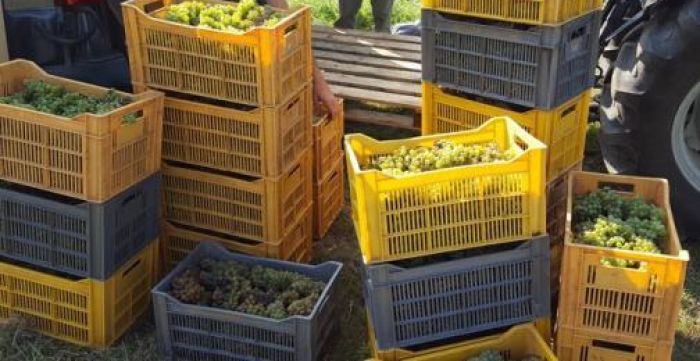
harvest report
21.09.2005
2005 Harvest Report from Eric Texier
<p>Northern <span class="zalup"><span> <glossary term="Rhône Region" title="1209">Rhône</glossary><span>:</span></span></span> <glossary title="1167">drought</glossary> was really severe until first week of September, then heavy rains. Very ripe grapes, but with some <glossary title="182">rot</glossary> on early ripening places. <glossary term="Sorting" title="1380">Sorting</glossary> will be the key. As balanced as 2003, probably.<br />
<br />
Whites are very nice (very like 1996 in <glossary title="1205">Mâconnais</glossary>) ripe and balanced. Very tiny <glossary title="1129">yields</glossary> (three <glossary title="142">barrels</glossary> only) of <glossary term="Roussanne" title="878">Roussanne</glossary> in <span class="zalup"><span><glossary term="Brézème" title="204">Brézème</glossary><span>.</span></span></span> <glossary title="373">Côte Rôtie</glossary> to be <glossary title="521">harvested</glossary> next week. <glossary title="326">Condrieu</glossary> is done, very "<glossary title="95">alsacian</glossary>" in style. Since the <glossary title="71">acidity</glossary> were very high and the ripeness perfect, I <glossary title="1104">vinified</glossary> the Vernon fruits in the <glossary title="972">Spatlese</glossary> style (7.5 % alc, 85 g/l RS, 8.1 g/l <glossary title="71">Acidity</glossary>).<br />
<br />
Southern <glossary title="1209">Rhône</glossary> : In the Gard (St Gervais) heavy rains early September, as usual now (the so called épisode cévenol, rare in the past, happens almost each year since 2002). But a drop in temperature and very strong <glossary title="667">mistral</glossary> since last Friday protect the grapes from <span class="zalup"><span><glossary title="182">rot</glossary><span>.</span></span></span> Strangely, the fruits taste very ripe and are not so high in <glossary term="alcoholic potential" title="1381">potential alcohol</glossary> (mid to high 12%). Cadinières will be <glossary title="521">harvested</glossary> next week, as well as <glossary title="508">Grenache</glossary> in <span class="zalup"><span><glossary term="Châteauneuf-du-Pape" title="277">Châteauneuf</glossary><span>,</span></span></span> where the rains were much lower than on the other bank of the <span class="zalup"><span><glossary term="Rhône River" title="856">Rhône</glossary><span>.</span></span></span> <glossary term="Seguret" title="1402">Seguret</glossary> and <glossary title="1062">Vaison</glossary> will be picked early October as usual, along with the<font color="#7b143e"><strong> <glossary term="Mourvèdre" title="692">Mourvèdre</glossary></strong></font> in <span class="zalup"><span><glossary title="277">Châteauneuf</glossary><span>.</span></span></span> This might be a very good year for the <glossary term="Vaucluse" title="1254">Vaucluse</glossary> <span class="zalup"><span><glossary title="113">appellations</glossary><span>.</span></span></span><br />
<br />
<glossary term="Mâcon" title="702">Mâcon</glossary> is fabulous. Low <glossary title="1129">yields</glossary> (25-30 <glossary title="">hl/ha</glossary>), perfect ripeness. Last <glossary title="827">press</glossary> on friday.<br />
<br />
<glossary title="721">Noble rot</glossary> is spreading on the best spots, and if we have good weather in October, this might be a real opportunity to make brillant <glossary term="Straw Wine" title="1189">Vin de Paille</glossary> from <span class="zalup"><span><glossary title="721">Noble Rot</glossary><span>.</span></span></span></p>
Article
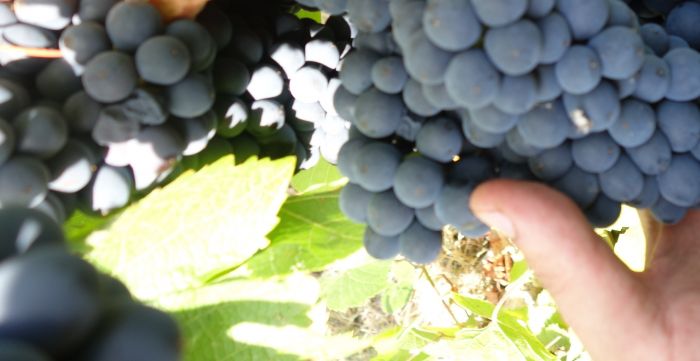
harvest report
22.09.2002
2002 Harvest Report from Eric Texier
<p>Today is the 3rd day of <glossary title="667">mistral</glossary> in a row, with cool temperatures during the nights (12°C yesterday night) and bright sunshine during the days. It's the best that could have happened.<br />
<br />
After two days of observation into the vineyard, I think sorting is going to be the key for quality, and through this, <glossary title="520">hand-picking</glossary> will again make a huge difference.<br />
<br />
So we'll do a double <glossary title="1380">sorting</glossary> : one into the vineyard (two buckets, one for the 100 % unrotten grapes and one for the partialy rotten ones) and then a slow <glossary title="1380">sorting</glossary> of the rotten ones on the <glossary title="1380">sorting</glossary> table with a team of four, 40 kg by 40 kg.<br />
<br />
To achieve this, we must double the <glossary title="521">harvest</glossary> team.<br />
<br />
The loss in quantity is going to be quite important (around 30%), but hopefully we'll be able to keep pretty decent grapes.<br />
<br />
The last measurements we did in <glossary title="277">Châteauneuf</glossary> and <glossary title="373">Côte-Rotie</glossary> brought the hope back: if <glossary title="667">mistral</glossary> goes on through the weekend, the result could be a nice surprise.</p>
Article























